Hilook 4K NVR Device Complete Guide, For the first-time access, you need to activate the video recorder by setting an admin password. No operation is allowed before activation. You can also activate the video recorder via web browser, SADP or client software.
For the first-time access, you need to activate the video recorder by setting an admin password. No operation is allowed before activation. You can also activate the video recorder via web browser, SADP or client software.
Before You Start
Power on your device.
Steps
- Select a language.
- Click Next.
- Input the same password in Password and Confirm Password.
/¡K Warning
Strong Password recommended-We highly recommend you create a strong password of your own choosing (Using a minimum of 8 characters, including at least three of the following categories: upper case letters, lower case letters, numbers, and special characters.) in order to increase the security of your product. And we recommend you reset your password regularly, especially in the high security system, resetting the password monthly or weekly can better protect your product.
- Activate network camera(s) connected to the device.
- Check Use Device Password as Default to use the device password to activate the inactive network camera(s).
- Enter a password to activate network camera(s).
- Optional: Set an email address for password resetting. When you forget your password, you can reset it by email.
- Check Enable.
- Enter an email address.
- Click Activate.
User Name admin
Password
Weak
Confirm Password
Camera Activation Password 0 Use Device Password as Default
Email to Reset Password 0 Enable
Email Address
Hilook 4K NVR Device Complete Guide
Read More :
- Hilook Hikvision Password Reset NVR/DVR/IPCAM NEW
- Hilook Firmware Software Tools
- How to Find The Encryption/Verification Code? Hilook Hikvision Annke
Figure 1-1 Activation
Admin user can use the unlock pattern to login. You can configure the unlock pattern after the device is activated.
Steps
- Use the mouse to draw a pattern among the 9 dots on the screen. Release the mouse when the pattern is done.
03 Note
- The pattern shall have 4 dots at least.
- Each dot can be connected for once only.
- Draw the same pattern again to confirm it. When the two patterns match, the pattern is configured successfully.
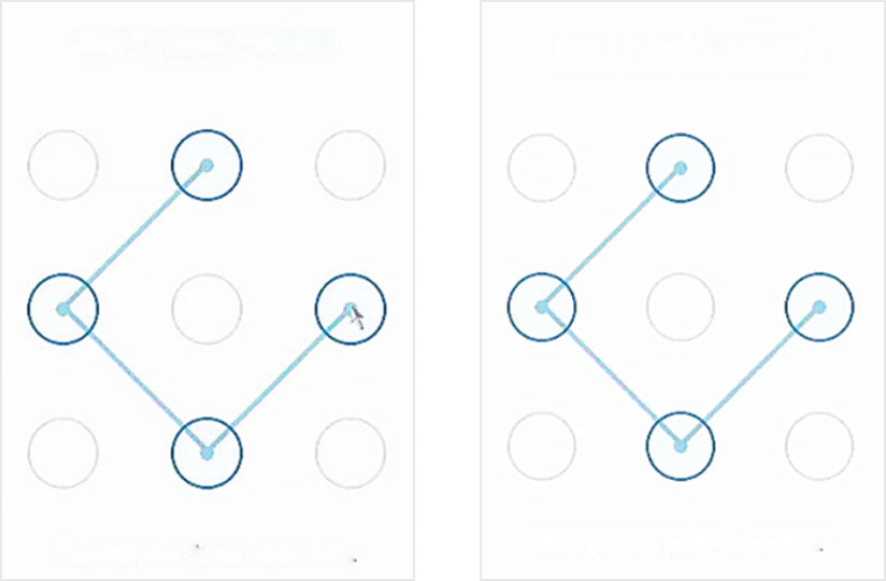
Unlock Pattern
Set Unlock Pattern
Release your finger when done
Figure 1-2 Set
Set Unlock Pattern
Draw pattern again to confirm
Steps
- Right click the mouse on live view interface.

Figure 1-3 Draw the Unlock Pattern
2. Draw the pre-defined pattern to unlock to enter the menu operation.
nXlNote
- If you have forgotten your pattern, you click Forgot My Pattern or Switch User to log in via password.
- If you have drawn the wrong pattern for more than 5 times, the system will switch to the normal login mode automatically.
If your video recorder has logged out, you must login before operating the menu and other functions.
Steps
- Select User Name.
Welcome
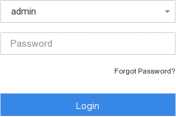
Figure 1-4 Login Interface
- Input password.
- Click Login.
- When you forget the password of the admin, you can click Forgot Password to reset the password.
- If you enter the wrong password 7 times, the current user account will be locked for 60 seconds.
- Click Target Detection at the upper-left corner, and select or to display the specified live target detection results. For result details, click View More.
HU Note
° Target Detection is only available for certain models.
° Target Detection is valid when HDD is installed.
° 0 is valid for motion detection, line crossing detection, intrusion detection, and facial detection.
- Click to start/stop auto-switch. The screen will automatically switch to the next one.
- Click to enter full screen mode.
- Double click a camera to view it in single-screen mode. Double click again to exit single-screen mode.
- Change a camera live view screen by dragging it from its screen to the desired screen.
- Scroll up/down to turn to previous/next screen.
- Position the cursor on a camera to show shortcut menu.

Figure 2-1 Shortcut Menu
Table 2-1 Shortcut Menu Description
| Button | Description |
| El | Start playing videos recorded in the latest five minutes. |
| □ | Digital zoom. You can adjust zoom-in times and view the desired area. |
| 0 | Click it to enter PTZ control mode. |
| Fl | Turn on/off live view audio. |
| ■ | Switch video stream. |
| [Ë] | Display rule frame and target frame. |
| Adjust image display effect according to the screen size. |
• In the live view interface, there are icons at the upper-right corner of the screen for each
camera, showing the camera recording and alarm status.
Table 2-2 Live View Icon Description
| Icon | Description |
| □ | Alarming (normal event and smart event). |
| i.:4 | Recording. |
• Right click your mouse to display the shortcut menu.
Menu
Ei Single Screen >
S Window Division >
< Previous Screen
> Next Screen
O Si art All! D-swHch
EJ Camera
® Playback
a FTZ Control
Figure 2-2 Right Click Shortcut Menu
You shall configure PTZ parameters before controlling a PTZ camera.
Steps
- Preview a camera in live view and click 0 on shortcut menu.
2. Click PTZ Parameter Settings.
Figure 2-3 PTZ Settings
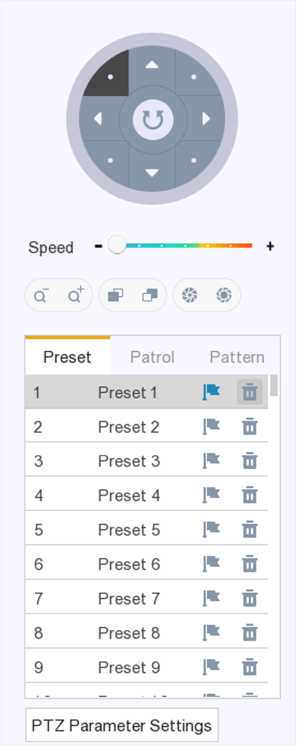
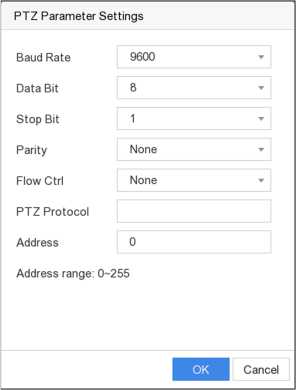
Figure 2-4 PTZ Parameter
- Set the PTZ camera parameters.
C0Note
- All parameters should be the same as the PTZ camera.
- For the Coaxitron camera/dome connected, you can select the PTZ protocol to UTC (Coaxitron). Ensure the selected protocol is supported by the connected camera/dome.
- The AHD and HDCVI cameras support coaxitron control.
- Selecting Coaxitron protocol will make other parameters unavailable, including baud rate, data bit, stop bit, parity and flow control.
Table 2-3 PTZ Panel Description
| Icon | Description |
| Direction buttons, and the auto-cycle button. | |
| Speed “ —— + | The speed of the PTZ movement. |
| ï / Q | Zoom -/+. |
| / J | Focus -/+. |
| • / $ | Iris -/+. |
-
-
- Customize Preset
-
Set a preset location where the PTZ camera would point to when an event occurs.
Steps
- Preview a camera in live view and click on shortcut menu.
- Select a desired preset in preset list.
- Use direction buttons to wheel the camera to required locations. Adjust zoom and focus as your desire.
- Click 1* .
What to do next
Double click a preset in the preset list to call it.
Patrol refers to a path consists of a series of presets with designated sequence. It provides dynamic live image for monitoring several presets.
Steps
- Preview a camera in live view and click on shortcut menu.
- Click Patrol.
- Select a desired patrol.
- Click Set.
- Click + .
- Configure key point parameters, such as the key point No., duration of staying for one key point and speed of patrol. The key point is corresponding to the preset. The preset number determines the order at which the PTZ will follow while cycling through the patrol. Duration refers to the time span to stay at the corresponding key point. Speed defines the speed at which the PTZ will move from one key point to the next.
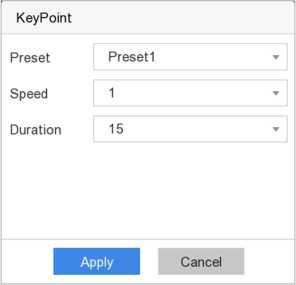
Figure 2-5 Patrol Settings
- Click Apply.
What to do next
Select a patrol and click Call to call it. The PTZ camera will move according the predefined patrol path.
Patroll ▼
Set Call
Figure 2-6 Call Preset
A pattern records the movement path and dwell time in a certain position. When you call a pattern, the PTZ camera will move according to the recorded path.
Steps
- Preview a camera in live view and click on shortcut menu.
- Click Pattern.
- Select a pattern.
- Click Record.
- Use direction buttons to wheel the camera to required locations. Adjust zoom and focus as your desire.
- Click Stop Recording. The previous PTZ camera moving path is recorded as a pattern.
What to do next
Select a pattern and click Call to call it. The PTZ camera will move according the predefined
pattern.
Go to Playback .
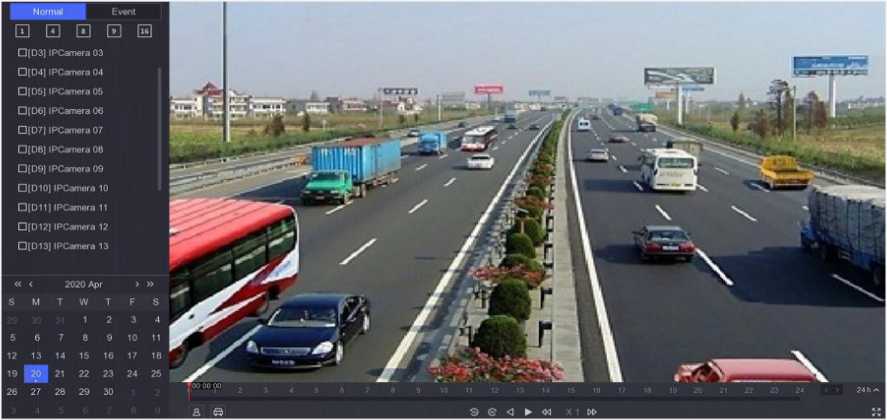
Figure 3-1 Playback
Table 3-1 Playback Interface Description
| Button | Operation | Button | Operation |
| S | Switch playback stream. | Clip video. | |
| □ | 30 s reverse. | □ | 30s forward. |
| ■ | Reverse playback. | Start playback. | |
| Speed down. | Speed up. | ||
| ES | Speed. | Lf J m | Full screen. |
| [■1 EU [SE dEI dû | Window division. |

Figure 3-2 Timeline
- Position the cursor on the timeline, drag the timeline to position to a certain time.
- Period marked with blue bar contains video. Red bar indicates the video in the period is event video.
- Scroll up/down to zoom out/in timeline.
Play back normal videos.
Steps
- Go to Playback .
- Select a camera from the camera list.
- Select a date on the calendar for playback.
C®Note
The blue triangle at the calendar date corner indicates there are available videos. For example, means video is available. 22 means no video.
- Optional: Position the cursor on playback window to show control bar.

Figure 3-3 Control Bar
Table 3-2 Button Description
| Button | Detection | Button | Detection |
| ■ | Add tag. | Zoom in/out playback image. | |
| Turn on/off audio. | 0 | Lock/unlock video. |
The smart playback function provides an easy way to get through the less effective information. When you select the smart playback mode, the system will analyze the video containing the motion detection, line crossing detection, or intrusion detection information.
Before You Start
Configure motion detection, line crossing detection, and intrusion detection rules and detection areas.
Steps
- Go to Playback .
- Click Smart.
- Select a camera.
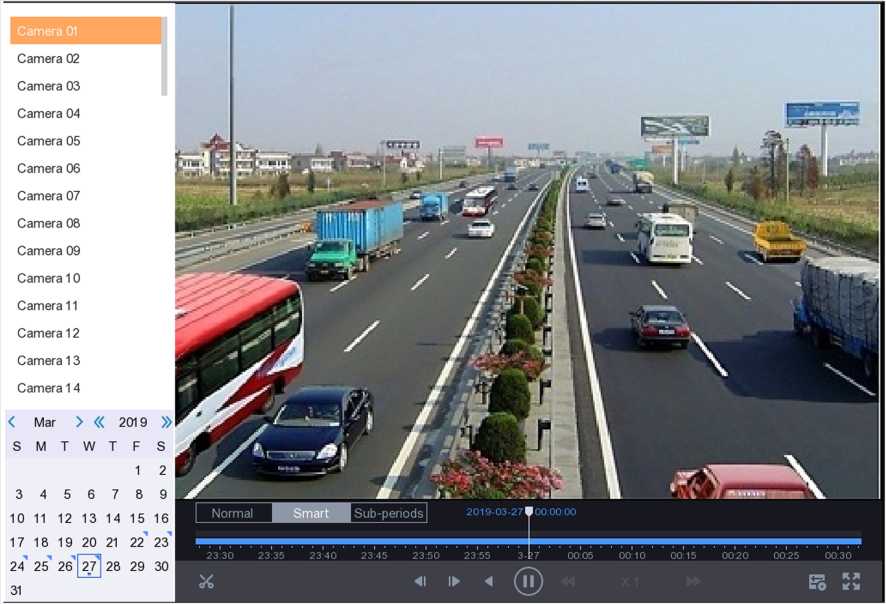
Figure 3-4 Smart Playback Interface
4. Position the cursor on playback window to show control bar.

Figure 3-5 Control Bar
Table 3-3 Button Description
| Button | Detection | Button | Detection | |
| ■ | Add tag. | Zoom in/out playback image. | ||
| ■ | Turn on/off audio. | ■ | Lock/unlock video. | |
| L3 | Configure detection area. | Draw detection area for motion detection. | ||
| H | Draw detection area for intrusion detection. | Draw detection line for line crossing detection. | ||
| ■ | Clear detection area. | |||
| 5.
6. |
Position the cursor on g
Line Crossing Detection Intrusion Detection Motion Detection Click gj] to configure the Do not Play Normal Vid If it is enabled, video |
j to set detection areas for smart event.
Click , and draw the detection line. Click H , and specify 4 points to set a quadrilateral region for intrusion detection. Only one region can be set. Click U , and drag to set the detection area manually. play strategy. eos without smart information will not be played. |
||
Normal Video
Set normal video playback speed. The option is only valid when Do not Play Normal Videos is unchecked.
Play Speed of Smart/Custom Video
Set playback speed of videos with smart information. The option is only valid when Do not
Play Normal Videos is enabled.
Play Strategy
Do not Play Normal Videos 0
Normal Video
—- _ ——— X 8
Play Speed of Smart/Custom Video
—————— X1
Cancel
Figure 3-6 Play Strategy
You can clip videos during playback. Video clips can be exported to the backup device (USB flash drives, USB HDDs, USB writer, SATA writer, etc.).
Before You Start
Connect a backup device to your video recorder.
Steps
- Start playback. Refer to Normal Playback for details.
- Click .
- Clip videos.
- Click Q, set start and end time, click OK.
- Set a time segment on time bar for clipping.

Figure 3-7 Time Segment
Steps
- Go to Search .
- Set search conditions.
- Click Search.
- Click to play the video.
- Click to lock the file. Locked file will not be overwritten.
- Select file(s), and click Export to export file(s) to backup device.
System Date
System Time
Resolution
Enable Wizard
Enable Password
Enable NTP
Interval (min)
NTP Server
NTP Port
Easy mode contains basic configurations. Go to Configuration , and click Easy Mode.
You can configure the output resolution, system time, mouse pointer speed, etc.
Steps
- Go to Configuration ^ System ^ General .
02-09-2019
19:35:38 ©
1024‘768i60HZ
□
0
□
60
time.windows com
123
Figure 5-1 General Settings
- Configure the parameters as your desire.
Enable Wizard
The wizard will pop up after the device starts up.
Enable Password
You need to enter password for authentication if the device automatically logged out.
Enable NTP
Network time protocol (NTP) is a networking protocol for time synchronization. The device can connect to NTP (network time protocol) server to sync time.
Interval (min)
Time interval between two time synchronization with NTP server.
NTP Server
IP address of the NTP server.
NTP Port
Port of the NTP server.
There is a default account: Administrator. The administrator user name is admin. Administrator has the permission to add, delete, and edit user. Guest user only has live view, playback, and log search permission.
Steps
- Go to Configuration ^ User .
- Click Add and confirm your admin password.
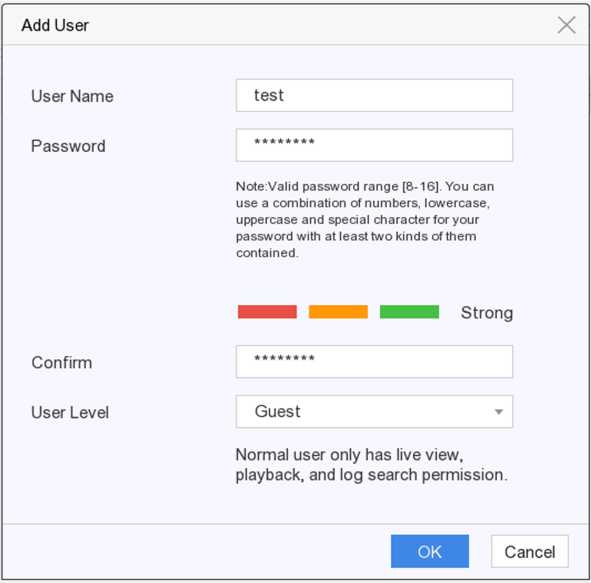
Figure 5-2 Add User
- Enter user name.
- Enter the same password in Password and Confirm.
/ * \ Warning
We highly recommend you create a strong password of your own choosing (Using a minimum of 8 characters, including at least three of the following categories: upper case letters, lower case letters, numbers, and special characters.) in order to increase the security of your product. And we recommend you reset your password regularly, especially in the high security system, resetting the password monthly or weekly can better protect your product.
- Click OK.
– Click / to edit user.
When you forgot your login pattern and password, the device will send an email contains verification code to your email for password resetting.
Steps
- Go to Configuration ^ User .
- Click Password Resetting Email.
- Enter admin password for authorization.
- Enter an email address.
- Click OK.
You can reset your password when you forgot your login pattern and password.
Steps
- Click Forgot Password at the password login interface.
- Click Next if you agree the Privacy Policy, you can scan the QR code to read it.
- Follow the wizard to reset password.
You can receive exception events hint in alarm center, and set exception linkage actions.
Steps
- Go to Configuration ^ System ^ Exception .
- Optional: Configure event hint. When the set events occur, you will receive hints in alarm center.
- Check Event Hint.
- Click at the upper-right corner of local menu to enter alarm center.
- Select an event type.
- Click Set to select events to hint.
- Set Exception Type
- Select Normal Linkage and Trigger Alarm Output type for exception linkage actions.

□ Audible Warning □ 10.96.15.145:8000->1
□ 10.96.15.1 45:8000->2
□ Notify Surveillance Center
□ Send Email
Figure 5-3 Exceptions
- Click Apply.
You shall properly configure the network settings before operating the device over network.
Steps
- Go to Configuration ^ Network ^ General .
![]()
DHCP
IPv4 Address
IPv4 Subnet Mask
IPv4 Default Gateway
Obtain DNS Automatically 0
Preferred DNS Server
Alternate DNS Server
Figure 5-4 Network
- Set network parameters.
DHCP
If the DHCP server is available, you can check Enable DHCP to automatically obtain an IP address and other network settings from that server.
Obtain DNS Automatically
If DHCP is checked. You can check Obtain DNS Automatically to automatically obtain
Preferred DNS Server and Alternate DNS Server.
HiLookVision provides mobile phone application and platform service to access and manage your connected devices, which enables you to get a convenient remote access to the video security system.
Steps
- Go to Configuration ^ Network ^ Platform Access .
- Select Access Type as HiLookVision.
- Check Enable. The service terms will pop up.
- Scan the QR code to read the service terms and privacy statement.
- Check I have read and agree to Service Terms and Privacy Statement. if you agree the service terms and privacy statement..
- Click OK.
- Optional: Check Stream Encryption. It requires to enter verification code in remote access and live view after this function is enabled.
- Optional: Check Custom, and edit Server Address.
- Enter a code in Verification Code. You can click Refresh to randomly generate a verification code.
- Bind your device with a HiLookVision account.
- Use a smart phone to scan the QR code, and download HiLookVision app. You can also download it from https://appstore.hikvision.com, or the QR code below. Refer to HiLookVision Mobile Client User Manual for details.

Figure 5-5 Download HiLookVision
2) Use HiLookVision to scan the device QR, and bind the device.
Hl® Note
If the device is already bound with an account, you should unbind with the current account.
- Click Apply.
What to do next
You can access your video recorder via HiLookVision.
Set an email account to receive event notification.
Before You Start
- Ensure your video recorder is in a local area network with an SMTP mail server.
- Configure your network parameters. Refer to General for details.
Steps
![]()
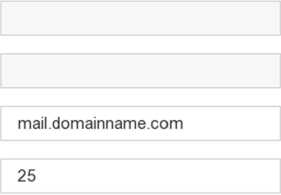
![]()
![]()
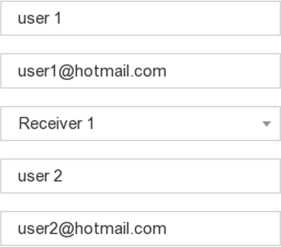
Server Authentication
User Name
Password
SMTP Server
SMTP Port
SSUTLS
Attached Picture
Sender
Sender’s Address
Select Receivers
Receiver
Receiver’s Address
Figure 5-6 Email
- Set email parameters
Server Authentication
(Optional), check it to enable the server authentication feature.
User Name
The user account of email sender for SMTP server authentication.
Password
The password of email sender for SMTP server authentication.
SSL/TLS
(Optional), check it to enable SSL/TLS if it required by the SMTP server.
Sender
The sender name.
Sender’s Address
The sender’s email address.
Select Receiver
Select a receiver. Up to 3 receivers are available.
Receiver
The receiver name.
Receiver’s Address
The receiver’s email address.
djNote
- For network cameras, the event images are directly sent as the email attachment. One network camera only sends one picture.
- For analog cameras, 3 attached pictures will be sent for one analog camera when an event occurs.
- Click Apply.
Add Network Camera by Device Password
Add network cameras which the password is the same as your video recorder.
Before You Start
- Ensure your network camera is on the same network segment with your video recorder.
- Ensure the network connection is valid and correct. Refer to General for details.
- Ensure the network camera password is the same as your video recorder.
Steps
- Go to Configuration ^ Camera ^ IP Camera . The online cameras on the same network segment with your video recorder are displayed in the camera list.
+ Ql UI 0 9 Search!-
□ No. I IP Address I Edit I Add/Delete I Security I Status I Camera Name
… 10.6.114.36 ~ + ©Active A
Figure 5-7 IP Camera Management Interface
- Click + to add the camera.
Before You Start
- Ensure your network camera is on the same network segment with your video recorder.
- Ensure the network connection is valid and correct.
- Ensure the network camera is activated.
Steps
- Go to Configuration ^ Camera ^ IP Camera .
- Click + .
- Set network camera parameters, including IP address, protocol, management port, etc. You can check Use IPC Active Password to use the device password to add network camera(s).
- Optional: Click Add More to add another network camera.
- Click OK.
| IP Camera Address | 192 1681 123 |
| Protocol | ONVIF |
| Management Port | 00 |
| T ransfer Protocol | Auto |
| User Name | admin |
| Password
Use IPC Active Password |
Figure 5-8 Add Network Camera
You can edit the IP address, protocol and other parameters of the added network cameras.
Steps
- Go to Configuration ^ Camera ^ IP Camera .
- Click / to edit the selected camera.
Channel Port
If the connected device is an encoding device with multiple channels, you can select the channel port No. to choose a connecting channel.
- Click OK.
Channel layout windows are ordered by channel number. You can change the camera linked channel number by dragging windows.
Steps
- Go to Configuration ^ Camera ^ Camera .
- Click Sort Channel.
- Drag a channel window to the channel number as your desire.
- Click Apply.
C®Note
After sorting channels, the device will reconnect to network cameras.
For the camera parameters that were only configurable via web browser, remote settings function provides an operation interface to configure remote camera parameters.
Before You Start
Ensure your camera is properly connected.
Steps
- Go to Configuration ^ Camera ^ IP Camera .
- Click Remote Settings
- After the device resource is initialized, select a camera.
- Set camera parameters.
The Network camera can be remotely upgraded through the device.
Before You Start
- Ensure you have inserted the USB flash drive to the device, and it contains the network camera upgrade firmware.
- Ensure your network camera is on the same network segment with your video recorder.
- Ensure the network connection is valid and correct.
Steps
- Go to Configuration ^ Camera ^ IP Camera .
- Click O .
- Click Yes to confirm.
- Select the camera upgrade firmware from your storage device.
- Click Upgrade to start upgrading. The camera will restarted automatically after upgrade completed.
Configure Advanced Camera Parameters
You can configure advanced camera parameters like camera IP address, camera password, etc.
Before You Start
- Ensure your network camera is on the same network segment with your video recorder.
- Ensure the network connection is valid and correct.
Steps
- Go to Configuration ^ Camera ^ IP Camera .
- Click ® .
- Set camera parameters like IP address, camera password, etc.
- Click Apply.
Configure OSD (On-Screen Display) settings for the camera, including date format, camera name, etc.
Steps
- Go to Configuration ^ Camera ^ OSD .
- Select a camera.
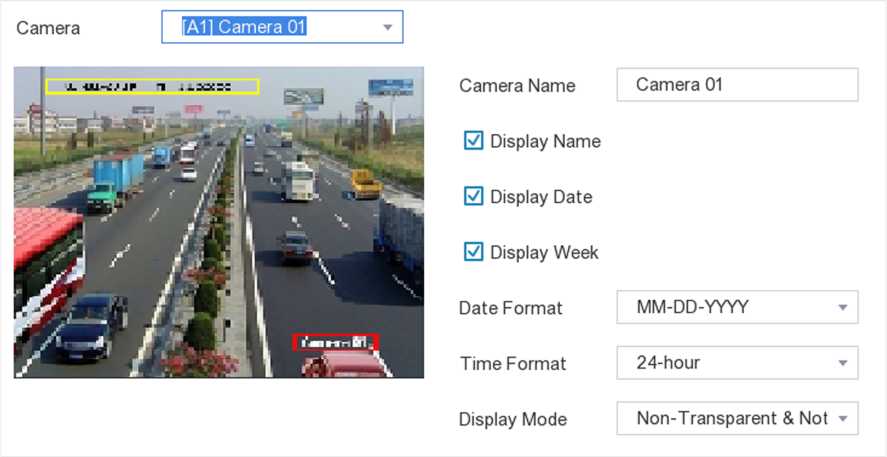
Figure 5-9 OSD
3. Drag the text frames on the preview window to adjust the OSD position.
4. Click Apply.
Motion detection enables the video recorder to detect the moving objects in the monitored area and trigger alarms.
Steps
- Go to Configuration ^ Camera ^ Motion Detection .
- Select a camera.
- Check Enable.
- Set the motion detection area.
- Click Draw Area or Clear to draw or clear areas. The first area is set as full screen by default.
- Click Full Screen to set the motion detection area as full screen. You can drag on the preview window to draw motion detection areas.
C® Note
The operation may differ according to different models.
- Adjust Sensitivity. Sensitivity allows you to calibrate how readily movement triggers the alarm. A higher value results in the more readily to triggers motion detection.
- Set analysis mode as AI or PIR.
AI
The motion detection event will be analyzed by your device.
PIR
The motion detection event will be analyzed by certain analog PIR cameras.
- Optional: Set Target Detection as Human or Vehicle to discard alarms which are not triggered by human or vehicle.
US Note
This function is only available for certain models.
- Set the arming schedule. Refer to Configure Arming Schedule for details.
- Set the linkage actions. Refer to Configure Alarm Linkage Action for details.
- Click Apply.
Steps
- Select Arming Schedule.
- Choose one day of a week and set the time segment. Up to eight time periods can be set within each day.
djNote
Time periods shall not be repeated or overlapped.
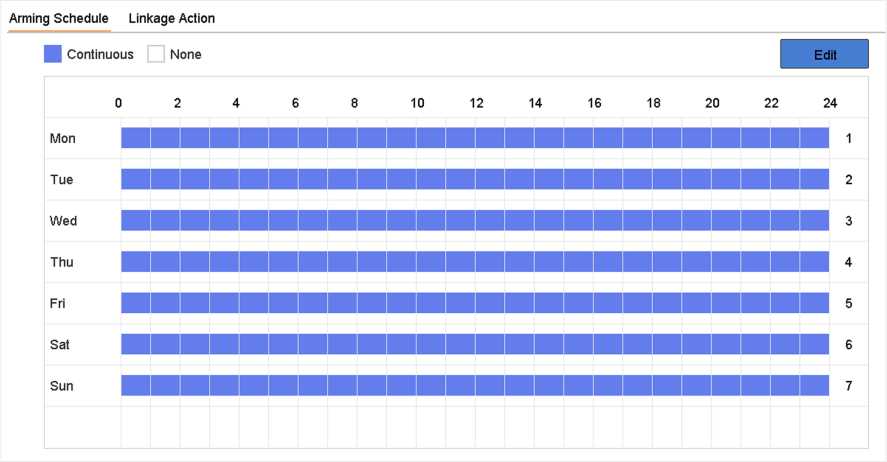
Figure 5-10 Set Arming Schedule
- Click Apply.
Configure Alarm Linkage Action
Alarm linkage actions will be activated when an alarm or exception occurs.
Steps
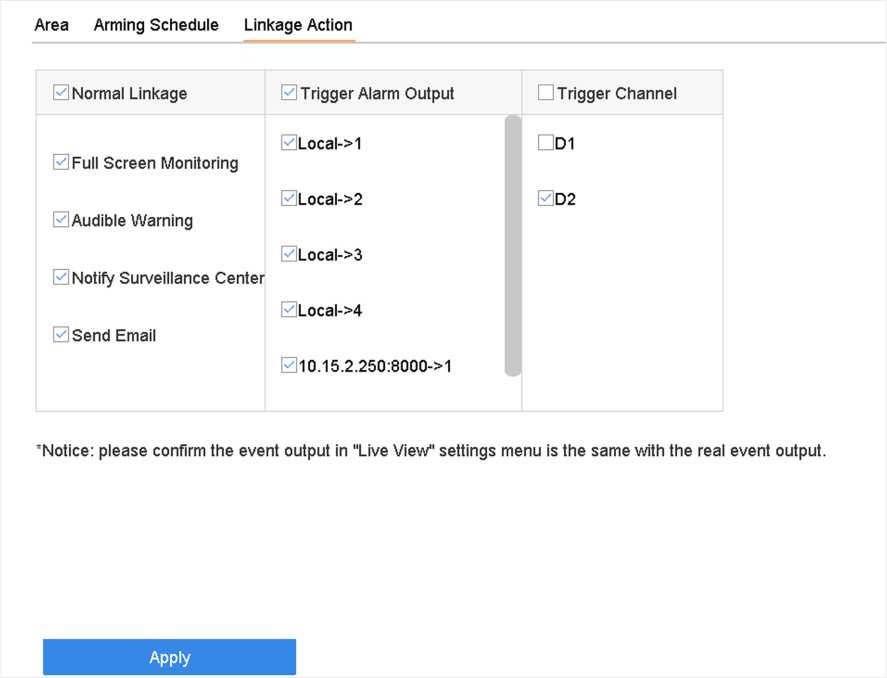
Figure 5-11 Linkage Actions
2. Set normal linkage actions, trigger alarm output, trigger recording channel, etc.
Full Screen Monitoring
The local monitor will display the alarming channel image in full screen when an alarm is triggered. It requires to select the alarming channel(s) in Trigger Channel.
Audible Warning
It will trigger an audible beep when an alarm is triggered.
Notify Surveillance Center
The device will send an exception or alarm signal to the remote client software when an alarm is triggered.
Send Email
It will send an email with alarm information when an alarm is triggered.
PTZ Linkage
It will trigger PTZ actions (e.g., call preset/patrol/pattern) when smart events occur.
3. Click Apply.
Add and manage switches.
Quick add switch(es) in the same network segment with the video recorder. If the switch is not activated, it will be added with the channel default password.
Steps
- Go to Configuration ^ Device Management ^ Switch.
- In the Online Device List, check the switch(es) to be added and click Add to add switch(es) in the same network segment with the video recorder using the channel default password.
Steps
- Go to Configuration ^ Device Management ^ Switch .
- In the Online Device List, click Add and set the parameters of the channel.
Table 5-1 Channel Parameter Description
| Parameter | Description |
| IP Address | The IP address of the switch. |
| Management Port | It is recommended to keep the default configuration. |
| User Name / Password | The user name / password of the switch. |
| Use the Login Password | Use the login password of the video recorder to add the switch. |
3. Click Add and Continue and repeat operation until all device have been added.
4. Click Add.
Configure non-video event.
Steps
- Go to Configuration ^ Device Management ^ Non-Video Event.
- Select the device.
- Select the Alarm Content.
- Set the arming schedule. Refer to Configure Arming Schedule for details.
- Set the linkage actions. Refer to Configure Alarm Linkage Action for details.
- Click Applyo
A newly installed hard disk drive (HDD) must be initialized before it can be used to save videos and information.
Before You Start
Install at least an HDD to your video recorder. For detailed steps, refer to Quick Start Guide.
Steps
- Go to Configuration ^ Record ^ Storage .
- Select an HDD.
- Click Init.
Repair Database
Repair an HDD that with error in database. Please operate it with the help of professional technical support.
Secure Erase
Secure erase will delete videos in the selected disk(s).
You can add the allocated NAS or IP SAN disk to the video recorder, and use it as a network HDD.
Steps
- Go to Configuration ^ Record ^ Storage .
- Click Add.
- Select NetHDD.
- Set Type as NAS or IPSAN.
- Enter NetHDD IP address.
- Click Search to search the available disks.
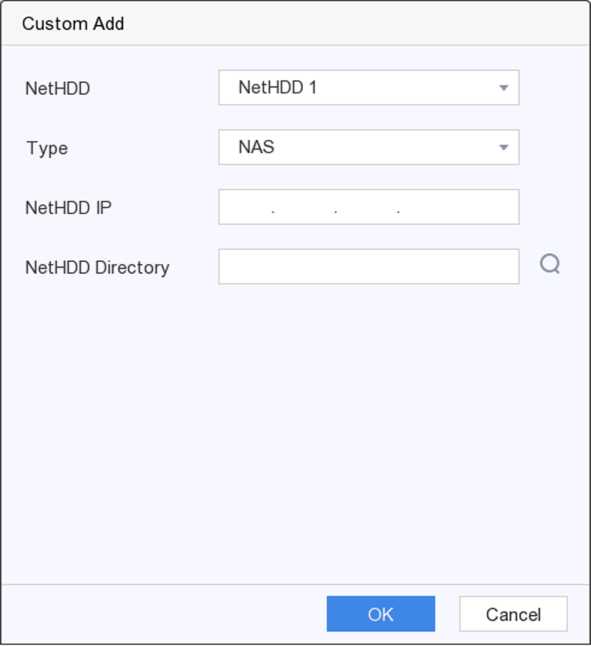
Figure 5-12 Add NetHDD
7. Select NAS disk from the list, or manually enter the directory in NetHDD Directory.
8. Click OK. The added NetHDD will be displayed in the storage device list.
5.5.2 Configure Recording Schedule
Video recorder will automatically start/stop recording according to the configured schedule.
Configure Continuous Recording
Steps
- Go to Configuration ^ Record ^ Parameter .
- Set the continuous main stream/sub-stream recording parameters for the camera. Refer to Configure Recording Parameter for details.
- Go to Configuration ^ Record ^ Schedule .
- Select recording type as Continuous. Refer to Edit Schedule for details.
You can configure the recording triggered by the motion detection, line crossing detection, and intrusion detection.
Steps
- Go to Configuration ^ Event ^ Smart Event .
- Configure the event detection and select the channels to trigger the recording when an event occurs.
- Go to Configuration ^ Record ^ Parameter .
- Set the continuous main stream/sub-stream recording parameters for the camera. Refer to Configure Recording Parameter for details.
- Go to Configuration ^ Record ^ Schedule .
- Select recording type as Event. Refer to Edit Schedule for details.
Steps
- Go to Configuration ^ Record ^ Schedule .
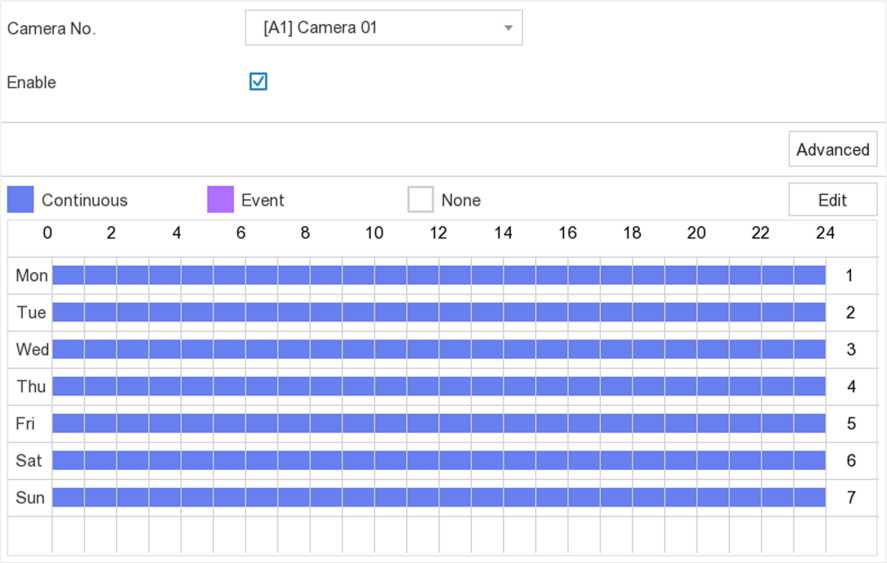
Figure 5-13 Recording Schedule
Continuous
Event
Recording triggered by all event triggered alarm.
- Select a camera in CameraNo.
- Check Enable.
- Configure the recording schedule.
Edit a. Click Edit.
Schedule b. Select a day to configure in Weekday.
- To set an all-day recording schedule, check All Day and select schedule type.
- To set other schedules, uncheck All Day, and set Start/End Time and schedule type.
Note
Up to 8 periods can be configured for each day. And the time periods cannot be overlapped with each other.
- Click OK to save the settings and go back to upper level menu.
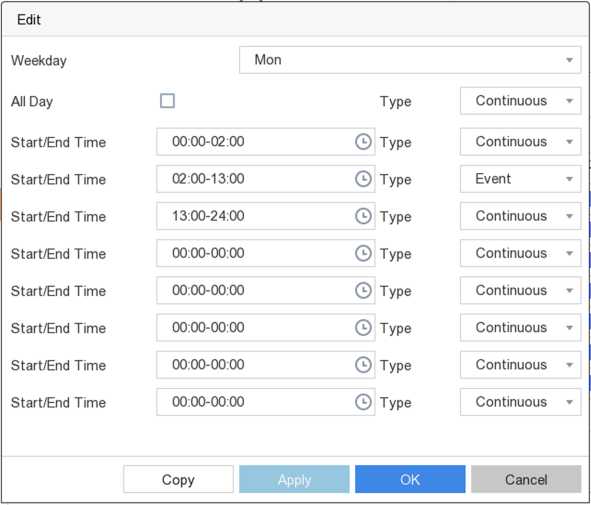
Figure 5-14 Edit Schedule
- Click to select schedule type as Continuous or Event.
Draw
Schedule
5. Click Apply.
- On the table, drag the mouse on the desired period to draw a colored bar.
5.5.3 Configure Recording Parameter
Steps
- Go to Configuration ^ Record ^ Parameter .
- Configure recording parameters.
Main Stream
Main stream refers to the primary stream that affects data recorded to the hard disk drive and will directly determine your video quality and image size. Comparing with the substream, the main stream provides a higher quality video with higher resolution and frame rate.
Sub-Stream
Sub-stream is a second codec that runs alongside the mainstream. It allows you to reduce the outgoing internet bandwidth without sacrificing your direct recording quality. Sub-stream is often exclusively used by smartphone applications to view live video. Users with limited internet speeds may benefit most from this setting.
Frame Rate
Frame rate refers to how many frames are captured each second. A higher frame rate is advantageous when there is movement in the video stream, as it maintains image quality throughout.
Resolution
Image resolution is a measure of how much detail a digital image can hold: the greater the resolution, the greater the level of detail. Resolution can be specified as the number of pixelcolumns (width) by the number of pixel-rows (height), e.g.,1024×768.
Bitrate
The bit rate (in Kbit/s or Mbit/s) is often referred to as speed, but actually defines the number of bits/time unit and not distance/time unit.
C® Note
Higher resolution, frame rate, and bitrate provide you better video quality, but it also requires more internet bandwidth and uses more storage space on the hard disk drive.
Chapter 6 Configuration (Expert Mode)
Go to Configuration , and click Expert Mode at the lower-left corner.
Configure Basic Settings
You can configure the language, system time, output resolution, mouse pointer speed, lock screen password, etc.
Go to Configuration ^ System ^ General ^ Basic Settings , configure the parameters as your desire, and click Apply.
Language
The default language is English.
VGA/HDMI Resolution
Select the output resolution, which must be the same with the resolution of the VGA/HDMI display.
Lock Screen Password
You need to enter password for authentication if the screen is locked.
Mouse Pointer Speed
Set the speed of mouse pointer. 4 levels are configurable.
Wizard
The wizard will pop up after the device starts up.
Enhanced Decoding Mode
Disabling enhanced decoding mode will reduce the local decoding capability by half and restart the device.
DST (Daylight Saving Time) refers to the period of the year when clocks are moved one period ahead. In some areas worldwide, this has the effect of creating more sunlit hours in the evening during months when the weather is the warmest.
Go to Configuration ^ System ^ General ^ DST Settings , configure the parameters as your desire, and click Apply.
You can configure your device name, lock screen time, output mode, etc.
Go to Configuration ^ System ^ General ^ More Settings , configure the parameters as your desire, and click Apply.
Device Name
Edit the video recorder name.
Device No.
The number is required in the connection with remote control, network keyboard, etc. Edit the serial number of video recorder. The device number ranges from 1 to 255, and the default value is 255.
Lock Screen
Set timeout time for lock screen.
Menu Output Mode
Choose output to display local menu.
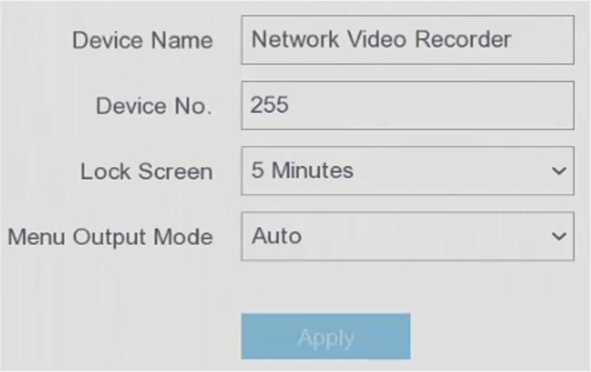
Figure 6-1 More Settings
You can configure the output interface, mute or turning on the audio, event output interface, etc.
Steps
- Go to Configuration ^ System ^ Live View ^ General .
| Video Output Interface | VGA/HDMI – | |||
| Live View Mode | 4*4 – | |||
| Dwell Time | No Switch | ▼ | ||
| Event Output | VGA/HDMI – | |||
| Full Screen Monitoring Dwell Time | 10s – | |||
Enable Audio Output
![]() Volume
Volume
Figure 6-2 Live View-General
- Configure the Live View parameters.
Live View Mode
Select the live view window division.
Dwell Time
The time to dwell in a camera before switching to next camera when auto-switch in live view is enabled.
Event Output
Select the output to show event video.
Full Screen Monitoring Dwell Time
Set the time to show alarm event image.
Enable Audio Output
Turn on/off audio output for the selected video output.
Volume
Adjust the live view, playback, and two-way audio volume for the selected video output interface.
- Click Apply.
Steps
- Go to Configuration ^ System ^ Live View ^ View .
- Select Video Output Interface to configure.
- Click to select a window and click a camera No. in the camera list you would like to display. + means no camera is displayed on the window.
- Optional: Click Q / f? to start/stop live view of all the cameras in order.
- Click Apply.
Configure Channel-Zero Encoding
Enable the channel-zero encoding when you need to get a remote view of many channels in real time from a web browser or CMS (Client Management System) software, in order to decrease the bandwidth requirement without affecting the image quality.
Steps 1. Go 2. Set 3. Go
to Configuration ^ System ^ Live View ^ General . Video Output Interface as Channel-Zero.
to Configuration ^ System ^ Live View ^ Channel-Zero .
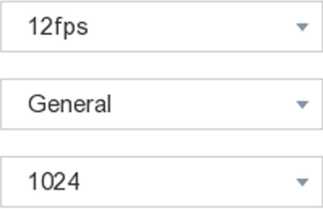 Enable Channel-Zero Encoding
Enable Channel-Zero Encoding
Frame Rate
Max. Bitrate Mode
Max. Bitrate(Kbps)
Figure 6-3 Channel-Zero
- Check Enable Channel-Zero Encoding.
- Configure Frame Rate, Max. Bitrate Mode, and Max. Bitrate. The higher frame rate and bitrate settings result in higher bandwidth requirement.
- Click Apply.
Refer to User for details.
TCP/IP must be properly configured before you operate video recorder over network.
Steps
- Go to Configuration ^ Network ^ General ^ TCP/IP .
- Configure network parameters.
Working Mode
Multi-address Mode
The parameters of the two NIC cards can be configured independently. You can select LAN1 or LAN2 in the NIC type field for parameter settings. You can select one NIC card as default route. And then the system is connecting with the extranet and the data will be forwarded through the default route.
Net-fault Tolerance Mode
The two NIC cards use the same IP address, and you can select the Main NIC to LAN1 or LAN2. By this way, in case of one NIC card failure, the video recorder will automatically enable the other standby NIC card so as to ensure the normal running of the whole system.
Load Balance Mode
By using the same IP address and two NIC cards share the load of the total bandwidth, which enables the system to provide two Gigabit network capacity.
C® Note
Working mode is only available for certain models.
NIC Type
Select NIC type as your desire. If your device supports Wi-Fi dongle function, the NIC of Wi-Fi dongle would be selectable after a suitable Wi-Fi dongle is installed.
DHCP
If the DHCP server is available, you can check Enable DHCP to automatically obtain an IP address and other network settings from that server.
MTU
The maximum transmission unit (MTU) is the size of the largest network layer protocol data unit that can be communicated in a single network transaction.
Default Route
Select a route as your desire. If your device supports Wi-Fi dongle function, the route of Wi-Fi dongle would be selectable after a suitable Wi-Fi dongle is installed.
Auto Obtain DNS
If DHCP is checked. You can check Obtain DNS Automatically to obtain Preferred DNS Server and Alternate DNS Server.
Dynamic domain name server (DDNS) maps dynamic user IP addresses to a fixed domain name server.
Before You Start
Register DynDNS, PeanutHull and NO-IP services with your ISP.
Steps
- Go to Configuration ^ Network ^ General ^ DDNS .
Enable 0
DDNS Type DynDNS ▼
Server Address
Device Domain Name
User Name
Password
Status DDNS is disabled
Figure 6-4 DDNS
- Check Enable.
- Select a DDNS type.
- Enter parameters including service address, domain name, etc.
- Click Apply.
What to do next
You can view DDNS status in Status.
Two ways are provided for port mapping to realize the remote access via the cross-segment network, UPnP™ and manual mapping.
Before You Start
Enable the UPnP™ function of your router if UPnP™ is required. When the device network working mode is multi-address, the default device route should be on the same network segment as the LAN IP address of the router.
Steps
- Configuration ^ Network ^ General ^ NAT .
- Check Enable.
- Select Mapping Type as Manual or Auto
Auto The port mapping items are read-only, and the external ports are set by the router automatically. You can click Refresh to get the latest status of the port mapping.
Manual Select an external port type. Click / to edit External Port. You can use the default external port No., or change it according to actual requirements. External Port indicates the port No. for port mapping in the router.
The value of the RTSP port No. should be 554 or between 1024 and 65535, while the value of the other ports should be between 1 and 65535 and the value must be different from each other. If multiple devices are configured for the UPnP™ settings under the same router, the value of the port No. for each device should be unique.
- Set the virtual server of your router, including internal source port, external source port, etc. The virtual server parameters shall be corresponding with your device port.
Set different port types to enable relevant functions as your desire.
Go to Configuration ^ Network ^ General ^ More Settings .
Alarm Host IP/Port
The device will send the alarm event or exception message to the alarm host when an alarm is triggered. The remote alarm host must have the client management system (CMS) software installed.
Alarm Host IP refers to the IP address of the remote PC on which the CMS software (e.g., iVMS-4200) is installed, and the Alarm Host Port (7200 by default) must be the same as the alarm monitoring port configured in the software.
Server Port
For remote client software access. Ranges from 2000 to 65535. The default value is 8000.
HTTP Port
For remote web browser access. The default value is 80.
Multicast IP
Multicast can be configured to enable live view for cameras that exceed the maximum number allowed through network. A multicast IP address covers Class-D IP ranging from 224.0.0.0 to 239.255.255.255 and it is recommended to use the IP address ranging from 239.252.0.0 to 239.255.255.255.
When adding a device to the CMS software, the multicast address must be the same as that of the device.
RTSP Port
RTSP (Real Time Streaming Protocol) is a network control protocol designed for use in entertainment and communications systems to control streaming media servers. The port is 554 by default.
Output Bandwidth Limit
You can check the checkbox to enable output bandwidth limit.
Output Bandwidth
After enable the output bandwidth limit, input the output bandwidth.
CUl Note
- The output bandwidth limit is used for the remote live view and playback.
- The default output bandwidth is the maximum limit.
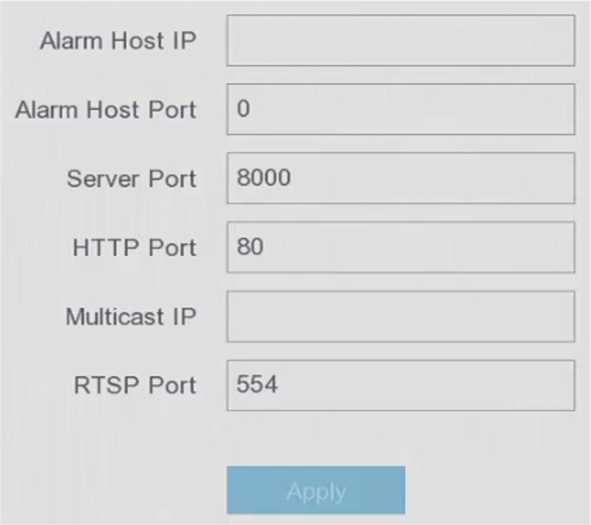
Figure 6-5 Port Settings
6.2.5 Upload Logs to the Server
You can upload system logs to the server for backup.
Steps
- Go to Configuration ^ Network ^ General ^ Log Server Settings .
Enable
Upload Time Interval (Fi) 1
Server IP Adtfress
Port 514
Apply
Figure 6-6 Log Server Settings
- Turn on Enable
- Set Upload Time Interval, Server IP Address, and Port.
- Optional: Click Test to test if parameters are valid.
- Click Apply.
Go to Configuration ^ Network ^ Platform Access . Refer to HiLookVision for details.
Go to Configuration ^ Network ^ Email . Refer to Email for details.
Add Automatically Searched Online Network Camera
Add the network cameras to your video recorder.
Before You Start
- Ensure your network camera is on the same network segment with your video recorder.
- Ensure the network connection is valid and correct.
- Ensure the network camera password is the same as your video recorder.
Steps
- Go to Configuration ^ Camera ^ Camera ^ IP Camera .
- Click Online Device. The online cameras on the same network segment will be displayed in the list.
+ Qi ICT O 9 Searchl-
□ No. I IP Address I Edit I Add/Delete I Security I Status I Camera Name
… 10.6.114.36 ~ + ©Active A
Figure 6-7 Online Device
- Select a network camera, and click Add to add it.
Add the network cameras to your video recorder.
Before You Start
- Ensure your network camera should be in the same network segment with your video recorder.
- Ensure the network connection is valid and correct.
- Activate the network camera to add.
Steps
- Go to Configuration ^ Camera ^ IP Camera .
- Click + .
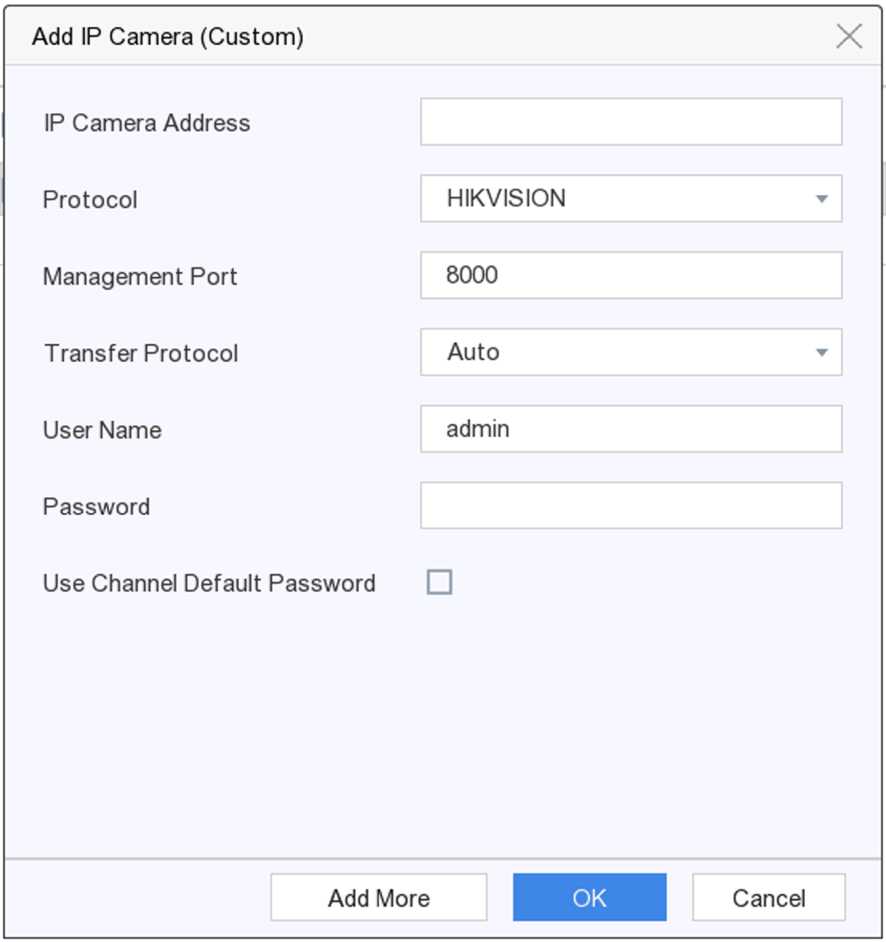
Figure 6-8 Add IP Camera
3. Enter information of the network camera to add.
Use Channel Default Password
If it is checked, the video recorder will add the camera by the set channel default password.
4. Click Add.
Add Network Camera on Different Network Segment
If your network camera is on a different network segment, the device can search its IP address within a range of IP addresses, and add it.
Before You Start
- Ensure the network connection is valid and correct.
- Ensure the network camera password is the same as your video recorder.
Steps
- Go to Configuration ^ Camera ^ Camera ^ IP Channel .
- Click Advanced Search.
- Enter Network Segment.
first three octets the camera IP address.
O If your network camera is not on the same network segment with the NVR and s… ,
□ Network Segment 192 . 168 . 0 . 0
□ Network Segment 192. 168.1 . ~
| Cancel
Figure 6-9 Enter Network Segment
- Click Add.
Add Network Camera Through Plug-and-Play
If an inactive network camera or third party ONVIF camera is connected to your network, the video recorder may automatically detect and add the camera, or notify you to manually add it.
Steps
- Go to Configuration ^ Camera ^ Camera ^ IP Channel .
- Click More.
- Select Plug-and-Play.
- Optional: Enable Auto Add Network Camera. The video recorder would automatically detect and add the inactive network camera or third party ONVIF camera.
Plug-and-Play x
Auto Add Network Camera «
OK
Figure 6-10 Auto Add Network Camera
‘Note
If you turn off Auto Add Network Camera, when an inactive network camera or third party ONVIF camera is connected to your network, the video recorder would automatically detect it and notify you to add it.
You can edit the IP address, protocol and other parameters of the added network cameras.
Steps
- Go to Configuration ^ Camera ^ IP Camera .
- Click / of an added network camera.
Channel Port
If the connected device is an encoding device with multiple channels, you can choose the channel to connect by selecting the channel port No. in the drop-down list.
- Click OK.
Example
Enter an example that illustrates the current task (optional).
What to do next
Enter the tasks the user should do after finishing this task (optional).
The Network camera can be remotely upgraded through the device.
Before You Start
- Ensure you have inserted the USB flash drive to the device, and it contains the network camera upgrade firmware.
- Ensure your network camera is on the same network segment with your video recorder.
- Ensure the network connection is valid and correct.
Steps
- Go to Configuration ^ Camera ^ Camera .
- Click .
- Click Yes to confirm.
- Select the camera upgrade firmware from your storage device.
- Click Upgrade to start upgrading. The camera will restarted automatically after upgrade completed.
Add Network Camera Through PoE
The PoE interfaces enable the device to transfer electrical power and data to connected PoE cameras. And the PoE interface supports the Plug-and-Play function. Connectable PoE camera number varies with device models. If you disable a PoE interface, you can also use it to connect to an online network camera.
Steps
- Go to Configuration ^ Camera ^ Camera ^ PoE Settings .
- Enable or disable long network cable mode by selecting Long Distance or Short Distance.
Long Distance
Long-distance (100 to 300 meters) network transmissions via PoE interface.
Short Distance
Short-distance (< 100 meters) network transmission via PoE interface.
C® Note
- The PoE ports are enabled with the short distance mode by default.
- The bandwidth of IP camera connected to the PoE via long network cable (100 to 300 meters) cannot exceed 6 Mbps.
- The allowed max. long network cable may be less than 300 meters depending on different IP camera models and cable materials.
- When the transmission distance reaches 100 to 250 meters, you must use the CAT5e or CAT6 network cable to connect with the PoE interface.
- When the transmission distance reaches 250 to 300 meters, you must use the CAT6 network cable to connect with the PoE interface.
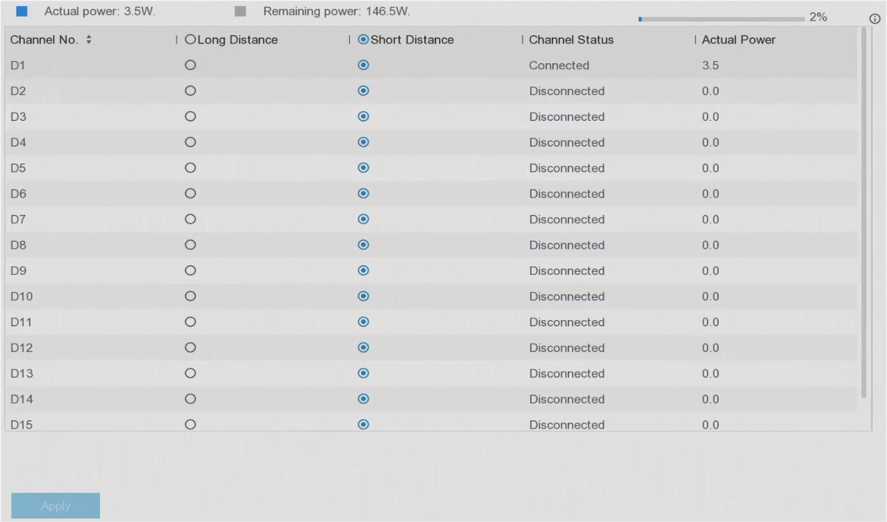
Figure 6-11 Add PoE Camera
- Click Apply.
- Connect PoE cameras to your device PoE interfaces with network cables.
What to do next
The connected PoE camera will be displayed in Configuration ^ Camera ^ Camera ^ IP Channel .
You can click its status to view live image.
You can use the PoE channel resource to connect a non-PoE network camera.
Steps
- Go to Configuration ^ Camera ^ Camera ^ IP Channel .
- Click jo of a channel with no linked network camera.
- Select Adding Method as Manual.
Plug-and-Play
The camera is physically connected to the PoE interface. You can click ® in the added device list to edit its parameters.
Manual
Add IP camera without physical connection via network cable.
- Set other parameters, such as user name, password, and IP address.
Configure Advanced Camera Parameters
You can configure advanced camera parameters like camera IP address, camera password, etc.
Before You Start
- Ensure your network camera is on the same network segment with your video recorder.
- Ensure the network connection is valid and correct.
Steps
- Go to Configuration ^ Camera ^ Camera .
- Click ® .
- Set camera parameters like IP address, camera password, etc.
- Click Apply.
You can disable a PoE channel to additionally increase a normal IP channel resource.
Go to Configuration ^ Camera ^ Camera ^ PoE Binding Configuration , and set the PoE channel as your desire.
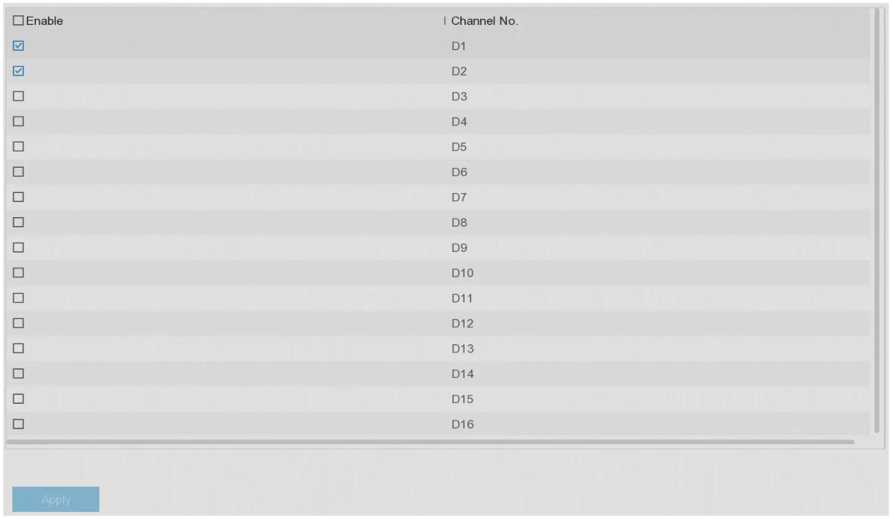
Figure 6-12 PoE Binding Configuration
Go to Configuration ^ Camera ^ Camera . Refer to Sort Channel Order for details.
Go to Configuration ^ Camera ^ Camera . Refer to Configure Remote Settings for details.
Import/Export IP Camera Configuration File
The information of added network camera can be generated into an excel file and exported to the local device for backup, including the IP address, manage port, password of admin, etc. And the exported file can be edited on your computer, like adding or deleting the content, and copy the setting to other devices by importing the excel file to it.
Before You Start
Connect a backup device like USB flash drive to your video recorder.
Steps
- Go to Configuration ^ Camera ^ IP Camera .
- Click El
- Click Export to export configuration files to the connected backup device.
- To import a configuration file, select the file from the selected backup device and click Import. After the importing process is completed, you must reboot the video recorder.
Steps
- Go to Configuration ^ Camera ^ IP Camera .
- Click O .
- Configure the parameters as your desire.
H.265 Auto Switch Configuration
If you enable the option, video recorder will automatically switch to H.265 stream for the network camera (which supports H.265 video format) for the initial access.
Upgrade
Upgrade the added network cameras.
Channel Default Password Management
Change the default password of activating and adding network camera.
Configure the OSD (On-Screen Display), image settings, exposure settings, day/night switch settings, etc.
Steps
- Go to Configuration ^ Camera ^ Display .
- Select Camera.
- Configure parameters as your desire.
OSD Settings
Configure the OSD (On-screen Display) settings for the camera, including date/time, camera name, etc.
Image Settings
Customize the image parameters including the brightness, contrast, and saturation for the live view and recording effect.
Exposure
Set the camera exposure time (1/10000 to 1 sec). A larger exposure value results in a brighter image.
Day/Night Switch
The camera can be set to day, night, or auto switch mode according to the surrounding illumination conditions.
Backlight
Set the camera’s wide dynamic range (0 to 100). When the surrounding illumination and the object have large differences in brightness, you should set the WDR value.
Image Enhancement
For optimized image contrast enhancement.

OSD Settings
Image Settings
Exposure
Day/Night Switch
Backlight
Image Enhancement
Camera Parameters Settings
Camera
Camera Name
[D1] Camera 01Camera 01
Figure 6-13 OSD
4. Drag the text frames on the preview window to adjust the OSD position.
5. Click Apply.
You are allowed to configure the privacy mask areas that cannot be viewed or recorded.
Steps
- Go to Configuration ^ Camera ^ Privacy Mask .
- Select Camera.
- Check Enable.
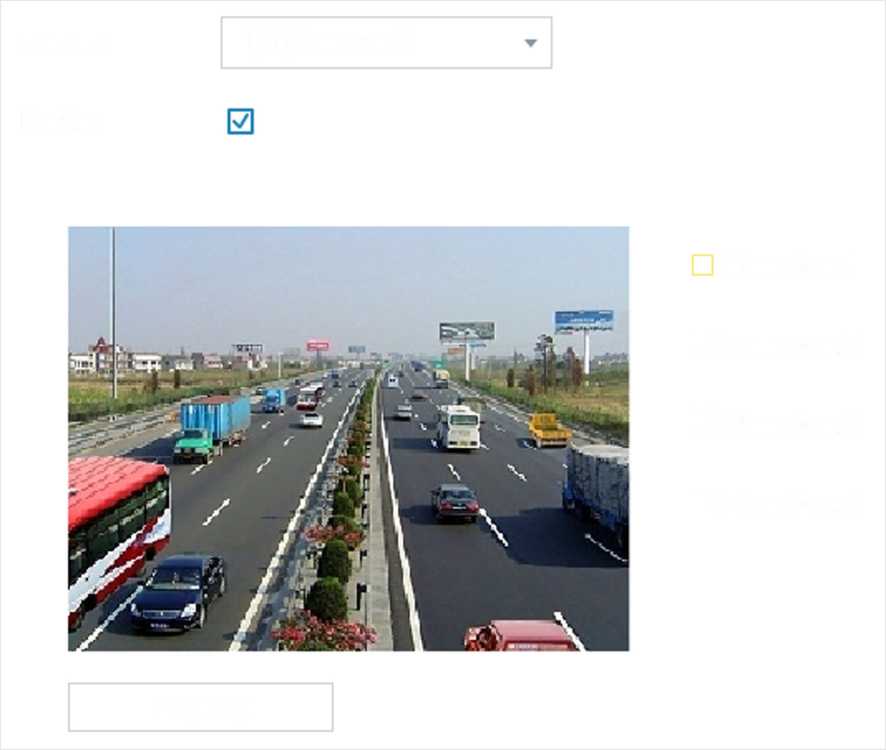
Clear Area 1
□ Clear Area 2
□ Clear Area 3
□ Clear Area 4
Clear All
Camera
[A1] Camera 01Enable
Figure 6-14 Privacy Mask
4. Drag to draw an area on the window. The frames of the areas will be marked with different colors.
OZlNote
Up to 4 privacy mask areas can be configured. The size of each area can be adjusted.
5. Click Apply.
Add and manage switches.
Quick add switch(es) in the same network segment with the video recorder. If the switch is not activated, it will be added with the channel default password.
Steps
- Go to Configuration ^ Device Management ^ Switch.
- In the Online Device List, check the switch(es) to be added and click Add to add switch(es) in the same network segment with the video recorder using the channel default password.
Steps
- Go to Configuration ^ Device Management ^ Switch .
- In the Online Device List, click Add and set the parameters of the channel.
Table 6-1 Channel Parameter Description
| Parameter | Description |
| IP Address | The IP address of the switch. |
| Management Port | It is recommended to keep the default configuration. |
| User Name / Password | The user name / password of the switch. |
| Use the Login Password | Use the login password of the video recorder to add the switch. |
3. Click Add and Continue and repeat operation until all device have been added.
4. Click Add.
Motion detection enables the video recorder to detect the moving objects in the monitored area and trigger alarms.
Steps
- Go to Configuration ^ Camera ^ Motion Detection .
- Select a camera.
- Check Enable.
- Set the motion detection area.
- Click Draw Area or Clear to draw or clear areas. The first area is set as full screen by default.
- Click Full Screen to set the motion detection area as full screen. You can drag on the preview window to draw motion detection areas.
- Adjust Sensitivity. Sensitivity allows you to calibrate how readily movement triggers the alarm. A higher value results in the more readily to triggers motion detection.
- Set analysis mode as AI or PIR.
AI
The motion detection event will be analyzed by your device.
PIR
The motion detection event will be analyzed by certain analog PIR cameras.
- Optional: Set Target Detection as Human or Vehicle to discard alarms which are not triggered by human or vehicle.
- Set the arming schedule. Refer to Configure Arming Schedule for details.
- Set the linkage actions. Refer to Configure Alarm Linkage Action for details.
- Click Apply.
Trigger alarm when the lens is covered and take alarm response actions.
Steps
- Go to Configuration ^ Event ^ Normal Event ^ Video Tampering .
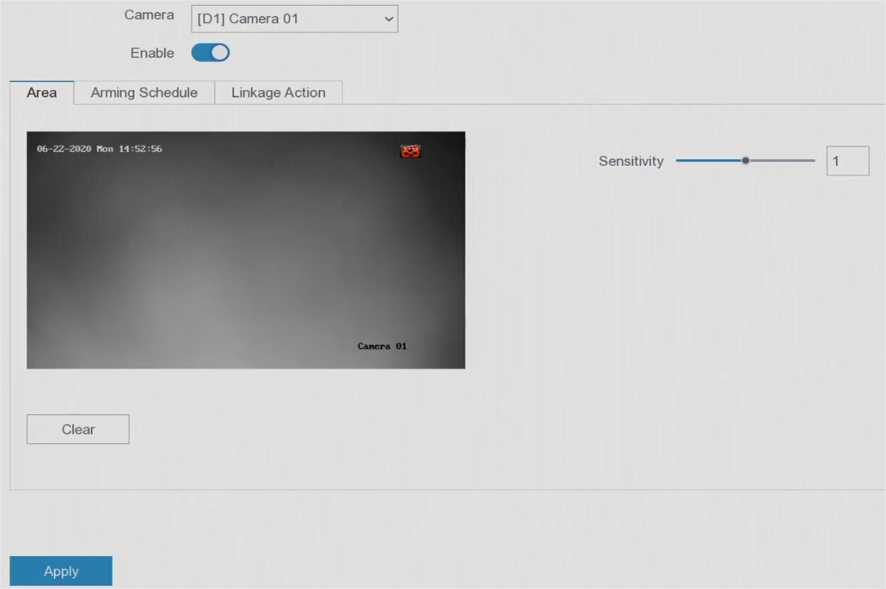
Figure 6-15 Video Tampering
- Set Camera.
- Turn on Enable.
- Adjust Sensitivity as your desire. The higher the value is, the more easily the video tampering can be triggered.
- Set the arming schedule. Refer to Configure Arming Schedule for details.
- Set the linkage actions. Refer to Configure Alarm Linkage Action for details.
- Click Apply.
Detect video loss of a camera and take alarm response actions.
Steps
- Go to Configuration ^ Event ^ Normal Event ^ Video Loss .
- Set Camera.
- Turn on Enable.
- Set the arming schedule. Refer to Configure Arming Schedule for details.
- Set the linkage actions. Refer to Configure Alarm Linkage Action for details.
- Click Apply.
Set linkage actions for an external sensor alarm.
Steps
- Go to Configuration ^ Event ^ Normal Event ^ Alarm Input .

Figure 6-16 Alarm Input
![]()
Note
Local alarm input: Local alarm input is triggered by the external device that connected to the video recorder’s terminal block.
- Click jo of a desired alarm input.

Figure 6-17 Edit Alarm Input
- Customize Alarm Name.
- Set alarm type as N.O (normally open) or N.C (normally closed).
- Set Settings as Input to enable the function.
C®Note
If you set Settings as Nonuse, the alarm input will be disabled. If you set Settings as One-Key Disarming, the selected linkage method(s) of the alarm input will be disabled.
- Set the arming schedule. Refer to Configure Arming Schedule for details.
- Set the linkage actions. Refer to Configure Alarm Linkage Action for details.
- Click Apply.
Trigger an alarm output when an alarm is triggered.
Steps
- Go to Configuration ^ Event ^ Normal Event ^ Alarm Output .
| Alarm Output No. | 1 Alarm Name | 1 Dwell Time | 1 Operation |
| 5s | £ | ||
| 5s |
Figure 6-18 Alarm Output
- Click <o of a desired alarm output.
- Customize Alarm Name.
- Select Dwell Time.
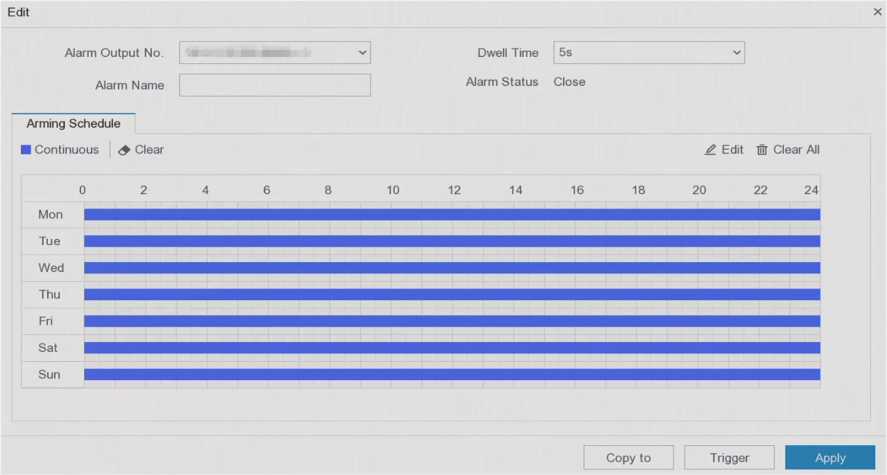
Figure 6-19 Edit Alarm Output
- Set Settings as Input to enable the function.
- Set the arming schedule. Refer to Configure Arming Schedule for details.
- Click Apply.
When light and audio alarm camera is connected, you can set the flashing time, flashing frequency, and arming schedule of the flashing light alarm.
Before You Start
Light and audio alarm camera is connected.
Steps
- Go to Configuration ^ Event ^ Normal Event ^ Flashing Light Alarm Output.
- Click E for any row.
- Set the Flashing Time and Flashing Frequency.
- Set the arming schedule. Refer to Configure Arming Schedule for details.
- ClickSave.
When light and audio alarm camera is connected, you can set the parameters and arming schedule of the audio alarm.
Before You Start
Light and audio alarm camera is connected.
Steps
- Go to Configuration ^ Event ^ Normal Event ^ Flashing Light Alarm Output.
- Click S for any row.
- Select the Audio Type as Alarm Sound, Prompt Sound, or Custom Audio.
CHjNote
- When you select the Alarm Sound, you also need to select the alarm sound type.
- When you select the Alarm Sound, you also need to upload the custom audio, enter the audio name and select the uploaded audio in the drop-down box of Custom Audio.
- Set the Alarm Times and Sound Volume.
- Set the arming schedule. Refer to Configure Arming Schedule for details.
- ClickSave.
Exception events can be configured to take the event hint in the live view window and trigger alarm outputs and linkage actions.
Steps
- Go to Configuration ^ Event ^ Normal Event ^ Exception .
- Configure event hint. When the set events occur, you will receive hints in alarm center.
- Enable Event Hint.
- Select events to hint. Choose from:
- Click @ of Event Hint Configuration to select events.
- Click in the upper-right corner of local menu to enter alarm center to select events.
- Select Exception Type to set its linkage actions.
Event Hint
Set Event Hint 0
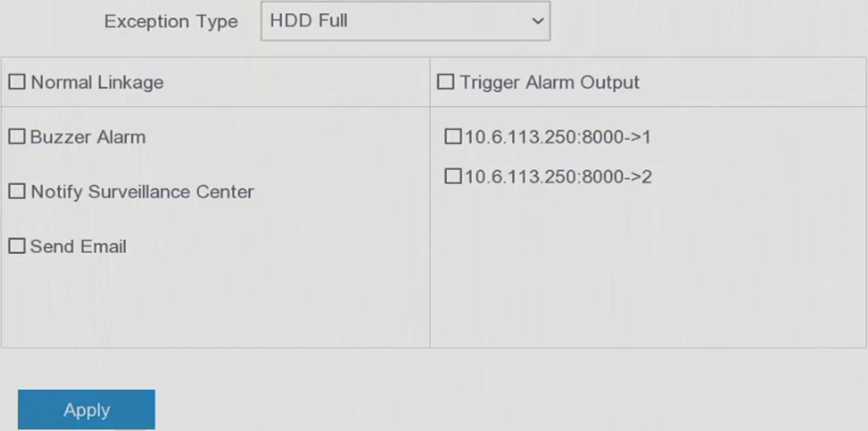
Figure 6-20 Exceptions
4. Set the arming schedule. Refer to Configure Arming Schedule for details.
5. Click Apply.
Perimeter protection includes line crossing detection, intrusion detection, region entrance detection, and region exiting detection.
OU Note
Perimeter protection is only available for certain device models or camera models.
Line crossing detection detects people, vehicles, and objects crossing a set virtual line. The detection direction can be set as bidirectional, from left to right or from right to left.
Steps
- Go to Configuration ^ Event ^ Perimeter Protection ^ Line Crossing .
- Set Camera.
- Select VCA Mode.
By NVR
The event will be analyzed by NVR. The device can analyze videos that contain human and vehicle. Only the target of selected type (human or vehicle) will trigger alarms, which can reduce false alarms that are caused by other objects.
By Camera
The event will be analyzed by camera.
- Turn on Enable.
- Set the detection rules and detection areas.
- Set Arming Area.
- Set Direction as A<->B, A->B, or A<-B.
A<->B
Only the arrow on the B side shows. An object crossing a configured line in both directions can be detected and trigger alarms.
A->B
Only an object crossing the configured line from the A side to the B side can be detected.
B->A
Only an object crossing the configured line from the B side to the A side can be detected.
- Click Max. Size and draw a quadrilateral in the preview window to set the maximum draw area size.
- Click Min. Size and draw a quadrilateral in the preview window to set the minimum draw area size.
- Click Draw Area and draw a quadrilateral in the preview window by specifying four vertexes of the detection region.
- Adjust Sensitivity. Sensitivity allows you to calibrate how readily movement triggers the alarm. A higher value results in the more readily to triggers motion detection.
- Optional: Set Detection Target as Human or Vehicle to discard alarms which are not triggered by human or vehicle.
C® Note
This function is only available for certain models.
- Set the arming schedule. Refer to Configure Arming Schedule for details.
- Set the linkage actions. Refer to Configure Alarm Linkage Action for details.
- Click Apply.
Intrusion detection function detects people, vehicles, or objects that enter and loiter in a predefined virtual region.
Steps
- Go to Configuration ^ Event ^ Perimeter Protection ^ Intrusion .
- Select Camera to configure.
- Turn on Enable.
- Set the detection rules and detection areas.
- Select Arming Area.
- Adjust Time Threshold and Sensitivity.
Sensitivity
The size of the object that can trigger the alarm. The higher the value is, the more easily the detection alarm will be triggered. Its range is [1-100].
Time Threshold
Range [1s-10s], the threshold for the time of the object loitering in the region. When the duration of the object in the defined detection area is longer than the set time, the alarm will be triggered.
- Optional: Set Target Detection as Human or Vehicle to discard alarms which are not triggered by human body or vehicle.
C® Note
This function is only available for certain models.
- Click Draw Area and draw a quadrilateral in the preview window by specifying four vertexes of the detection region.
- Set the arming schedule. Refer to Configure Arming Schedule for details.
- Set the linkage actions. Refer to Configure Alarm Linkage Action for details.
- Click Apply.
Region entrance detection function detects people, vehicle or other objects which enter a predefined virtual region from the outside place, and some certain actions can be taken when the alarm is triggered.
Steps
- Go to Configuration ^ Event ^ Smart Event ^ Region Entrance .
- Select Camera to configure.
- Check Enable Region Entrance Detection.
- Check Save VCA Picture to save the captured pictures of VCA detection.
- Set the detection rules and detection areas.
- Select Arming Area. Up to 4 arming areas are selectable.
- Click Draw Area and draw a quadrilateral in the preview window by specifying four vertexes of the detection region.
- Adjust Sensitivity. Sensitivity: Range [0-100]. The higher the value is, the more easily the detection alarm can be triggered.
- Set the arming schedule.
- Set the linkage actions.
- Click Apply.
Region exiting detection function detects people, vehicle or other objects which exit from a predefined virtual region, and some certain actions can be taken when the alarm is triggered.
Steps
- Go to Configuration ^ Event ^ Smart Event ^ Region Exiting .
- Select Camera to configure.
- Check Enable Region Exiting Detection.
- Check Save VCA Picture to save the captured pictures of VCA detection.
- Set the detection rules and detection areas.
- Select Arming Area. Up to 4 arming areas are selectable.
- Click Draw Area and draw a quadrilateral in the preview window by specifying four vertexes of the detection region.
- Adjust Sensitivity. Sensitivity: Range [0-100]. The higher the value is, the more easily the detection alarm can be triggered.
- Set the arming schedule.
- Set the linkage actions.
- Click Apply.
Configure non-video event.
Steps
- Go to Configuration ^ Device Management ^ Non-Video Event.
- Select the device.
- Select the Alarm Content.
- Set the arming schedule. Refer to Configure Arming Schedule for details.
- Set the linkage actions. Refer to Configure Alarm Linkage Action for details.
- Click Applyo
The device supports the event detection modes of thermal network cameras: fire detection, temperature detection, etc. You can configure the arming schedule and linkage actions of the selected event.
Before You Start
Add a thermal network camera to your device and make sure the camera is activated.
Steps
- Go to Configuration ^ Event ^ Other Events .
- Select a thermal camera detection event.
- Set Camera.
- Set the arming schedule. Refer to Configure Arming Schedule for details.
- Set the linkage actions. Refer to Configure Alarm Linkage Action for details.
- Click Apply.
Steps
- Click Arming Schedule.
- Choose one day of a week and set the time segment. Up to eight time periods can be set within each day.
[Z@Note
Time periods shall not be repeated or overlapped.
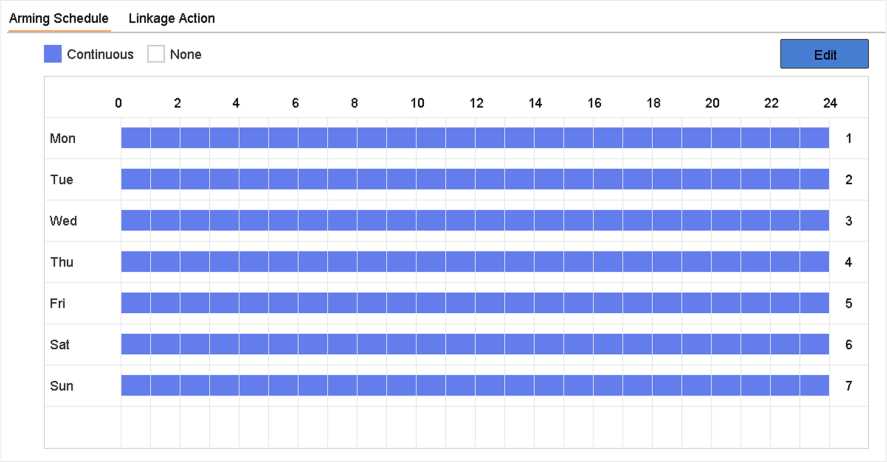
Figure 6-21 Set Arming Schedule
Configure Full Screen Monitoring
When an alarm is triggered, the local monitor displays in full screen the video image from the alarming channel configured for full screen monitoring. And when the alarm is triggered simultaneously in several channels, you must configure the auto-switch dwell time.
Steps
- Go to Configuration ^ System ^ Live View ^ General .
- Set the event output and dwell time.
Event Output
Select the output to show event video.
Full Screen Monitoring Dwell Time
Set the time in seconds to show alarm event image. If alarms are triggered simultaneously in several channels, their full-screen images will be switched at an interval of 10 seconds (default dwell time).
- Go to Linkage Action interface of the alarm detection.
- Select Full Screen Monitoring alarm linkage action.
- Select the channel(s) in Trigger Channel settings you want to make full screen monitoring.
OS Note
Auto-switch will terminate once the alarm stops and back to the live view interface.
The audio warning enables the video recorder to trigger an audible beep when an alarm is detected.
Steps
- Go to Configuration ^ System ^ Live View ^ General .
- Enable Audio Output and set Volume.
- Go to Linkage Action interface of the alarm detection.
- Select Audio Warning alarm linkage action.
The video recorder can send an exception or alarm signal to the remote alarm host when an event occurs. The alarm host refers to the computer installed with client software (e.g., iVMS-4200, iVMS-5200).
Steps
- Log into video recorder in web browser.
- Go to Configuration ^ Network ^ Advanced Settings ^ Other .
- Set Alarm Host IP and Alarm Host Port.
- In local menu, go to Linkage Action interface of the alarm detection.
- Select Notify Surveillance Center.
The video recorder can send an email with alarm information to a user or users when an alarm is detected.
Steps
- Switch to easy mode.
- Go to Configuration ^ System ^ Network ^ Email .
- Configure the Email settings.
- Go to Linkage Action interface of the alarm detection.
- Select Send Email alarm linkage action.
The alarm output can be triggered by the normal and smart events.
Steps
- Go to Linkage Action interface of the alarm input or event detection.
- Click Trigger Alarm Output.
- Select the alarm outputs to trigger.
- Go to Configuration ^ System ^ Event ^ Normal Event ^ Alarm Output .
- Select an alarm output item from the list. Refer to Alarm Outputfor the alarm output settings.
Video recorder can trigger the PTZ actions (e.g., call preset/patrol/pattern) when the alarm event, or VCA detection events occur.
Steps
- Go to Linkage Action interface of the alarm input or VCA detection.
- Select PTZ Linkage.
- Select the camera to perform the PTZ actions.
- Select the preset/patrol/pattern No. to call when the alarm events occur.
PTZ Linkage
PTZ Linkage [D1] IPCamera 01 –
(• Preset No. 5 –
C Patrol No. 1
OPattern No. 1
Figure 6-22 PTZ Linkage
CU Note
You can set one PTZ type only for the linkage action each time.
Video recorder will automatically start/stop recording according to the configured schedule.
Configure Continuous Recording
Steps
- Go to Configuration ^ Record ^ Parameter .
- Set the continuous main stream/sub-stream recording parameters for the camera.
- Go to Configuration ^ Record ^ Schedule .
- Select recording type as Continuous.
You can configure the recording triggered by the normal event or smart event.
Steps
- Go to Configuration ^ Event .
- Configure the event detection and select the cameras to trigger the recording when event occurs.
- Go to Configuration ^ Record ^ Parameter .
- Set the continuous main stream/sub-stream recording parameters for the camera.
- Go to Configuration ^ Record ^ Schedule .
- Select recording type as Event.
Steps
- Go to Configuration ^ Record ^ Schedule .
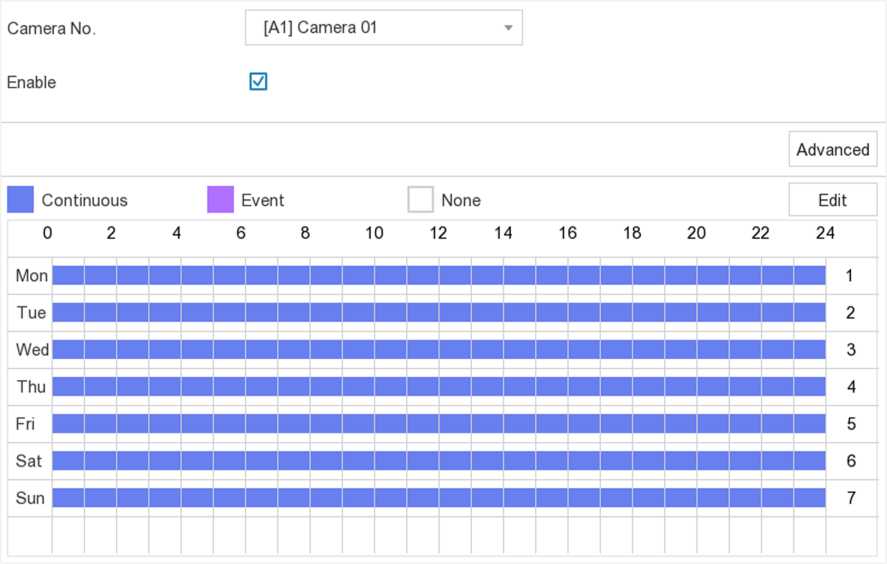
Figure 6-23 Recording Schedule
- Continuous: Continuous recording.
- Event: Recording triggered by all event triggered alarm.
- Select a camera in Camera No.
- Check Enable.
- Configure the recording schedule.
- Click Edit.
- Select a day to configure in Weekday.
- To set an all-day recording schedule, check All Day and select schedule Type.
- To set other schedules, uncheck All Day and set Start/End time and schedule Type.
CSNote
Up to 8 periods can be configured for each day. And the time periods cannot be overlapped with each other.
- Click OK to save the settings and go back to upper level menu.
Edit
| Weekday | Mon | ▼ | ||
| All Day | Type | Continuous ▼ | ||
| Start/End Time | 00:00-02:00 © Type | Continuous ▼ | ||
| Start/End Time | 02:00-13:00 © Type | Event ▼ | ||
| Start/End Time | 13:00-24:00 © Type | Continuous ▼ | ||
| Start/End Time | 00:00-00:00 © Type | Continuous ▼ | ||
| Start/End Time | 00:00-00:00 © Type | Continuous ▼ | ||
| Start/End Time | 00:00-00:00 © Type | Continuous ▼ | ||
| Start/End Time | 00:00-00:00 © Type | Continuous ▼ | ||
| Start/End Time | 00:00-00:00 © Type | Continuous ▼ | ||
| Copy | OK | Cancel |
Figure 6-24 Edit Schedule
Ü@Note
You can also Click to select schedule type as ContinuousorEvent.and On the table, drag the mouse on the desired period to draw a colored bar.
Main stream refers to the primary stream that affects data recorded to the hard disk drive and will directly determine your video quality and image size. Comparing with the sub-stream, the main stream provides a higher quality video with higher resolution and frame rate.
Sub-stream is a second codec that runs alongside the mainstream. It allows you to reduce the outgoing internet bandwidth without sacrificing your direct recording quality. Sub-stream is often exclusively used by smartphone applications to view live video. Users with limited internet speeds may benefit most from this setting.
Steps
- Go to Configuration ^ Record ^ Parameter to configure camera main stream and sub-stream parameters.
- Configure recording parameters.
Frame Rate
Frame rate refers to how many frames are captured each second. A higher frame rate is advantageous when there is movement in the video stream, as it maintains image quality throughout.
Resolution
Image resolution is a measure of how much detail a digital image can hold: the greater the resolution, the greater the level of detail. Resolution can be specified as the number of pixelcolumns (width) by the number of pixel-rows (height), e.g.,1024×768.
Bitrate
The bit rate (in kbit/s or Mbit/s) is often referred to as speed, but actually defines the number of bits/time unit and not distance/time unit.
Enable H.264+
The H.264+ mode helps to ensure the high video quality with a lowered bitrate. It can effectively reduce the need of bandwidth and HDD storage space.
Audio Source
The audio input signal source. If you select Audio Source as Camera Audio, it will transmit audio via coaxial cable, and make the local audio input signal unavailable. Ensure the camera supports to transmit audio via coaxial cable before selecting Audio Source as Camera Audio.
C®Note
Audio Source is only available for certain models.
If it is the first time you use your HDD, please initialize it after it is installed.
Before You Start
Install at least an HDD to your video recorder.
Steps
- Go to Configuration ^ Record ^ Storage .
- Select an HDD.
- Click Init.
Repair Database
Repair an HDD that with error in database. Please operate it with the help of professional technical support.
Secure Erase
Secure erase will delete videos in the selected disk(s).
You can add the allocated NAS or IP SAN disk to the video recorder, and use it as a network HDD.
Steps
- Go to Configuration ^ Record ^ Storage .
- Click Add.
- Select NetHDD.
- Set Type as NAS or IPSAN.
- Enter NetHDD IP address.
- Click Search to search the available disks.
- Select NAS disk from the list, or manually enter the directory in NetHDD Directory.
- Click OK.
Result
The added NetHDD will be displayed in the storage device list.
Each camera can be configured with an allocated quota for storing videos.
Steps
- Go to Configuration ^ Record ^ Storage Mode .
- Select Mode as Quota.
- Select a camera to set quota in Camera.
- Enter the storage capacity in the text fields of Max. Record Capacity (GB) and Max. Picture Capacity (GB).
Mode ® Quota O Group
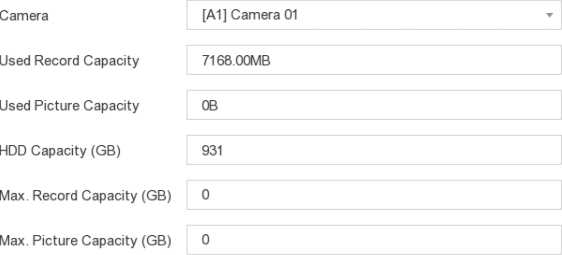
A Free Quota Space 931 GB
Figure 6-25 Quota
dJNote
When the quota capacity is set to 0, all cameras will use the total capacity of HDD for videos and pictures.
Steps
- Go to Configuration ^ Record ^ Advanced Settings .
- Configure the parameters as your desire.
Overwrite
- Disable: When the HDD is full, video recorder will stop writing.
- Enable: When hard drive is full, video record will continue to write new files by deleting the oldest files.
Enable HDD Sleeping
HDDs which are free of working for a long time will turn into sleep status.
Steps
- Click 0 at the upper-right corner.
- Select the restoring type.
Simple Restore
Restore all parameters, except the network (including IP address, subnet mask, gateway, MTU, NIC working mode, default route, server port, etc.) and user account parameters, to the factory default settings.
Factory Defaults
Restore all parameters to the factory default settings.
Restore to Inactive
Restore the device to the inactive status, and leave all settings unchanged except restoring user accounts.
The operation, alarm, exception and information of video recorder can be stored in logs, which can be viewed and exported at any time.
Steps
Steps
- Go to Configuration ^ Network ^ Advanced Settings .
- Configure the parameters as your desire.
RTSP
You can specifically secure the stream data of live view by setting the RTSP authentication.
RTSP Authentication Type
Two authentication types are selectable, if you select digest, only the request with digest authentication can access the video stream by the RTSP protocol via the IP address. For security reasons, it is recommended to select digest as the authentication type.
ISAPA
ISAPI (Internet Server Application Programming Interface) is an open protocol based on HTTP, which can realize the communication between the system devices (e.g., network camera, NVR, etc.). The video recorder is as a server, the system can find and connect the video recorder.
HTTP
The admin user account can disable the HTTP service from the GUI or the web browser. After the HTTP is disabled, all the related services, including the ISAPI, Onvif and Gennetc, will terminate as well.
HTTP Authentication
If you need to enable the HTTP service, you can set the HTTP authentication to enhance the access security. Two authentication types are selectable, for security reasons, it is recommended to select digest as the authentication type.
IP Camera Occupation Detection
The function detects the network camera status. If the network camera has been added by another video recorder, the network camera status will show as □ in Online Device list.
You can enable or disable buzzer with alarm linkage or exceptional linkage.
Steps
- Click ® at the upper-right corner.
- Click More.
- Go to Buzzer Switch.
- Turn on or turn off Enable.
The device will automatically restart according to the schedule.
Steps
- Click El at the upper-right corner.
- Click More.
- Go to Device Maintenance ^ Schedule Reboot .
- Turn on Enable.
- Set the reboot schedule.
- Click Apply.
Upgrade the camera(s) in the added device list.
Steps
- ClickMaintenance ( ) ^ More ^ Deice Maintenance ^ Camera Upgrade.
- Click Check for Updates.
- Upgrade camera.
- Select the channel to upgrade, and click the Upgrade on the right.
- Click Quick Upgrade to upgrade all channels that have updates.
You can mute the selected channel(s).
Steps
- Click El at the upper-right corner.
- Click More.
- Go to Device Maintenance ^ Device Status .
- In the Mute and Not Disturb column, check the corresponding channel(s).
Result
The selected channel(s) will be muted.
/»\ Warning
Do not shutdown or turn off the power during upgrade.
Before You Start
Store the upgrade firmware to a backup device, and connect it to your device.
Steps
- Go to Maintenance .
- Click O near Firmware.
- Select a backup device in Device Name.
- Select the upgrade firmware.
- Click Upgrade. Your device will reboot automatically.
Upgrade the device with the latest online firmware.
Before You Start
Enable HiLookVision and configure its parameters. Refer to HiLookVision for details.
Steps
- Go to Maintenance .
- Click O .
- Go to Online Upgrade .
- Download the latest firmware.
Auto Download The will automatically check and download the latest firmware.
Test Upgrade Click Test Upgrade to manually check and download the latest firmware. 5. Upgrade your device if a new firmware version is available. The device will reboot automatically.
When events occur, you can view their details in alarm center.
Select the events to hint in alarm center.
Steps
- Click in the upper-right corner of local menu to enter alarm center.
- Select Exception, Basic Event, or Smart Event to configure as your desire.
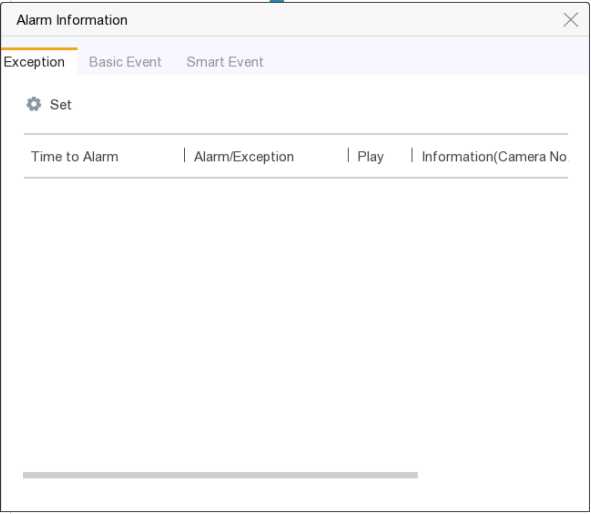
Figure 8-1 Alarm Centre
- Click ft and select events to hint.
- Click OK.
When the selected events occur, the alarm information will be displayed (locating in upperright corner of local menu).
Steps
- Click in upper-right corner of local menu.
- Select Exception, Basic Event, or Smart Event to view as your desire.
- Web Operation
You can get access to the video recorder via web browser.
You may use one of the following listed web browsers: Internet Explorer 11.0, Apple Safari, Mozilla Firefox, and Google Chrome. The supported resolutions include 1024×768 and above.
For certain models, you will have to download a web component plug-in, and install it. Otherwise, a few functions would be unavailable. The download address is http://
hikdownload.ys7.com/web/webplugin/windows/WebComponents/standard/ WebComponents.exe .
You shall acknowledge that the use of the product with Internet access might be under network security risks. For avoidance of any network attacks and information leakage, please strengthen your own protection. If the product does not work properly, please contact with your dealer or the nearest service center.
Steps
- Open web browser, input the IP address of the video recorder and then press Enter.
C@Note
If you have changed HTTP port, enter http://IP address:HTTP port in address bar. E.g., http: 192.168.1.64:81.
- Enter user name and password in the login interface.
- Click Login.
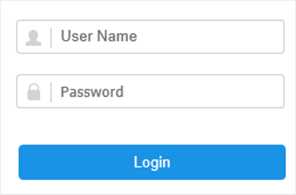
Figure 9-1 Login
4. Follow the installation prompts to install the plug-in.
C@Note
You may have to close the web browser to finish the installation of the plug-in.
After login, live view interface shows.
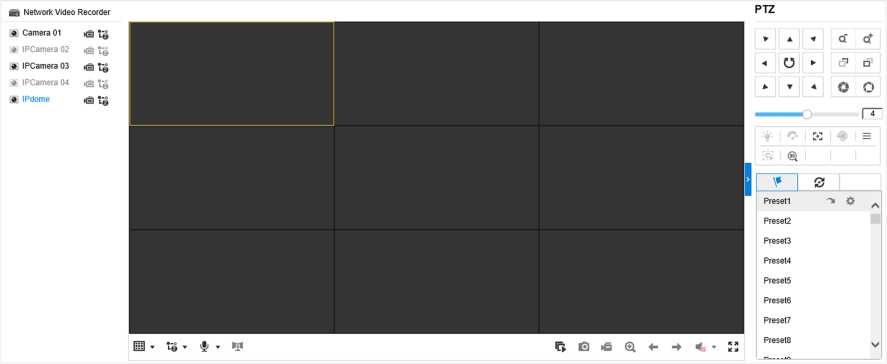
Figure 9-2 Live View
Click Playback to enter playback interface.
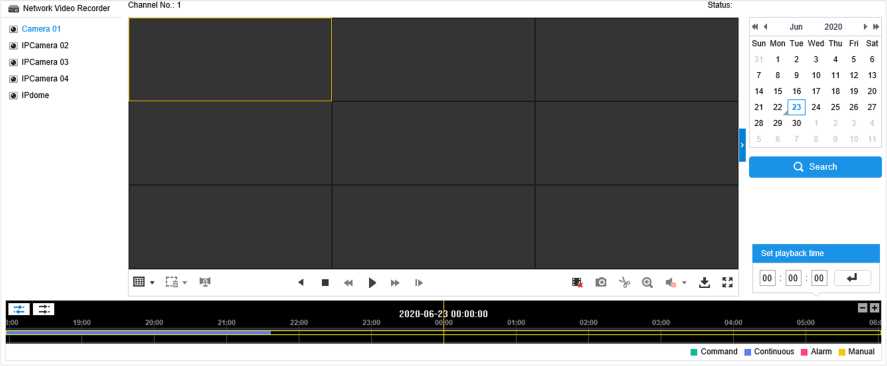
Figure 9-3 Playback
Click Configuration to enter configuration interface.
| 1 c | Local | Live View Parameters | |||||
| B | System | Protocol | ©TCP | o UDP | o MULTICAST | ||
| © | Network | Stream Type | (•) Main Stream | O Sub-Stream | |||
| S°o | Video/Audio | Play Performance | O Shortest Delay | (•) Balanced | O Fluent | ||
| 0 | Image | Rules | O Enable | (•) Disable | |||
| Ü | Event | POS/OSD Overlay | O Enable | (•) Disable | |||
| Storage | Image Size | (•) Auto-fill | 0 4 3 | O 16:9 | |||
| VCA | Auto Start Live View | O Yes | © No | ||||
| Image Format | © JPEG | O bmp | |||||
| Encryption Key | 1 | ||||||
| Record File Settings | |||||||
| Record File Size | o 256M | (•) 512M | O 1G | ||||
| Save record files to | I ” – . | ir | Browse | ||||
| Save downloaded files to | I . | || | Browse | ||||
| Picture and Clip Settings | |||||||
| Save snapshots in live view to | II | Browse | |||||
Figure 9-4 Configuration
Steps
- Go to Maintenance ^ System ^ Maintenance ^ Log .
- Set the search conditions.
- Click Search.
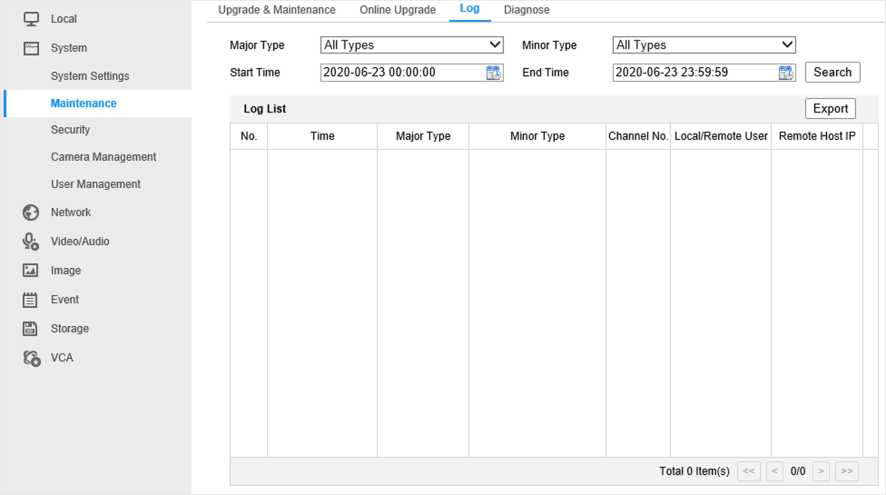
Figure 9-5 Log
Dual-Stream
Dual-stream is a technology used to record high resolution video locally while transmitting a lower resolution stream over the network. The two streams are generated by the DVR, with the main stream having a maximum resolution of 1080P and the sub-stream having a maximum resolution of CIF.
DVR
Acronym for Digital Video Recorder. A DVR is device that is able to accept video signals from analog cameras, compress the signal and store it on its hard drives.
HDD
Acronym for Hard Disk Drive. A storage medium which stores digitally encoded data on platters with magnetic surfaces.
DHCP
Dynamic Host Configuration Protocol (DHCP) is a network application protocol used by devices (DHCP clients) to obtain configuration information for operation in an Internet Protocol network.
HTTP
Acronym for Hypertext Transfer Protocol. A protocol to transfer hypertext request and information between servers and browsers over a network.
PPPoE
PPPoE, Point-to-Point Protocol over Ethernet, is a network protocol for encapsulating Point-to- Point Protocol (PPP) frames inside Ethernet frames. It is used mainly with ADSL services where individual users connect to the ADSL transceiver (modem) over Ethernet and in plain Metro Ethernet networks.
DDNS
Dynamic DNS is a method, protocol, or network service that provides the capability for a networked device, such as a router or computer system using the Internet Protocol Suite, to notify a domain name server to change, in real time (ad-hoc) the active DNS configuration of its configured hostnames, addresses or other information stored in DNS.
Hybrid DVR
A hybrid DVR is a combination of a DVR and NVR.
NTP
Acronym for Network Time Protocol. A protocol designed to synchronize the clocks of computers over a network.
NTSC
Acronym for National Television System Committee. NTSC is an analog television standard used in such countries as the United States and Japan. Each frame of an NTSC signal contains 525 scan lines at 60Hz.
NVR
Acronym for Network Video Recorder. An NVR can be a PC-based or embedded system used for centralized management and storage for IP cameras, IP Domes and other DVRs.
PAL
Acronym for Phase Alternating Line. PAL is also another video standard used in broadcast televisions systems in large parts of the world. PAL signal contains 625 scan lines at 50Hz.
PTZ
Acronym for Pan, Tilt, Zoom. PTZ cameras are motor driven systems that allow the camera to pan left and right, tilt up and down and zoom in and out.
USB
Acronym for Universal Serial Bus. USB is a plug-and-play serial bus standard to interface devices to a host computer.
Device Complete Guide







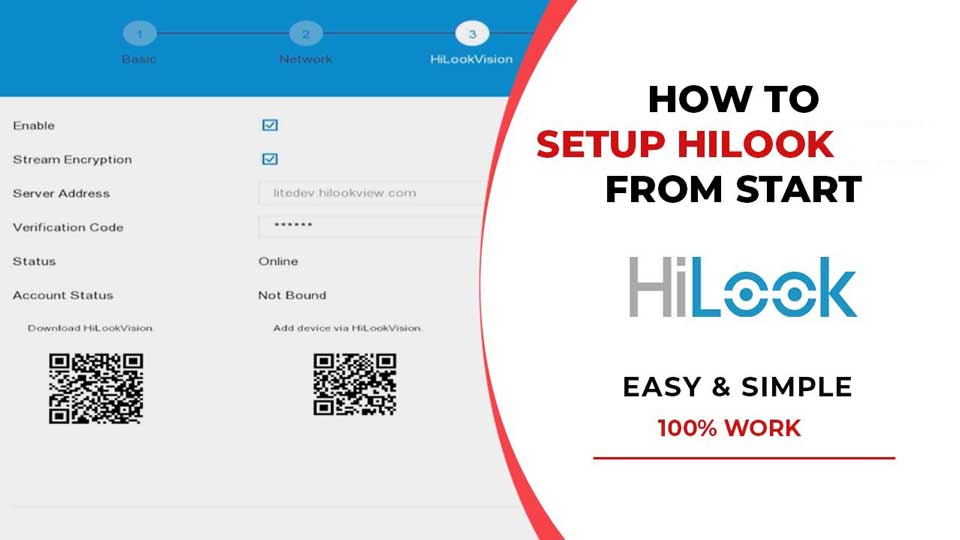

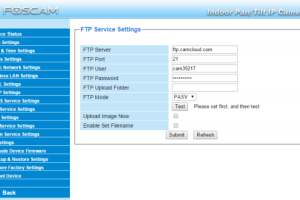
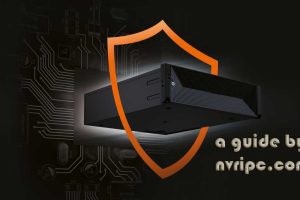
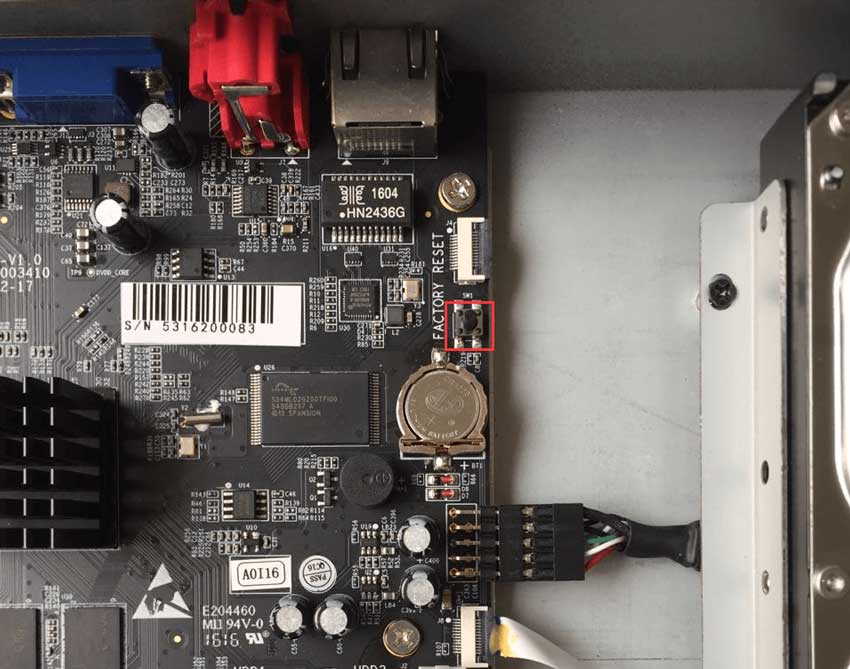
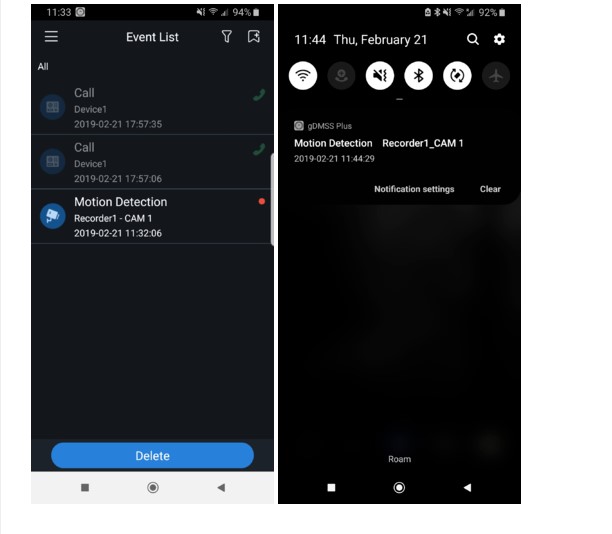
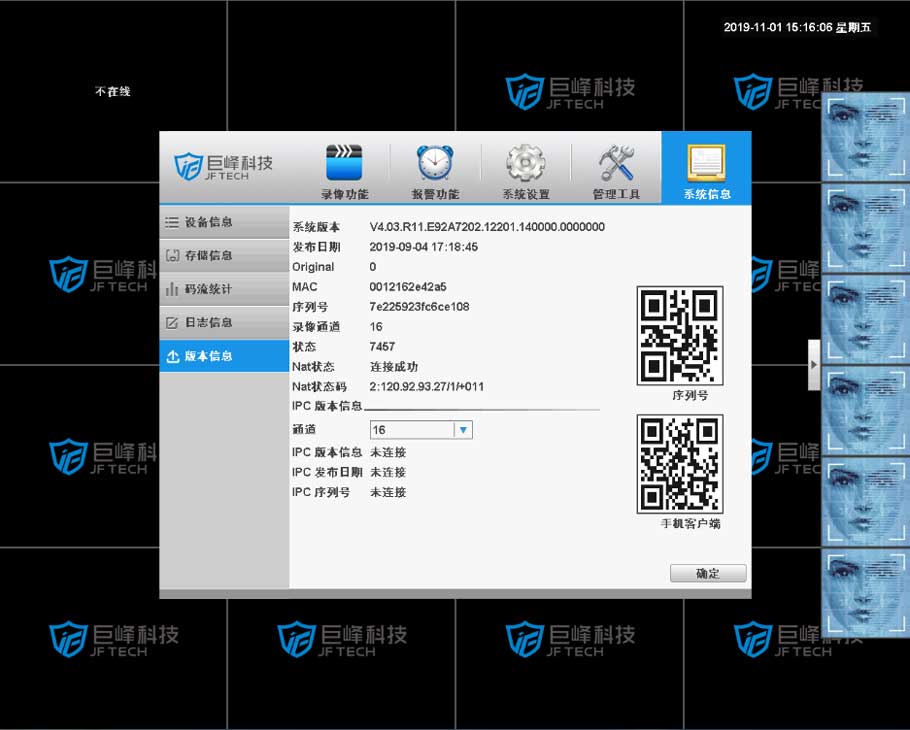

Add Comment